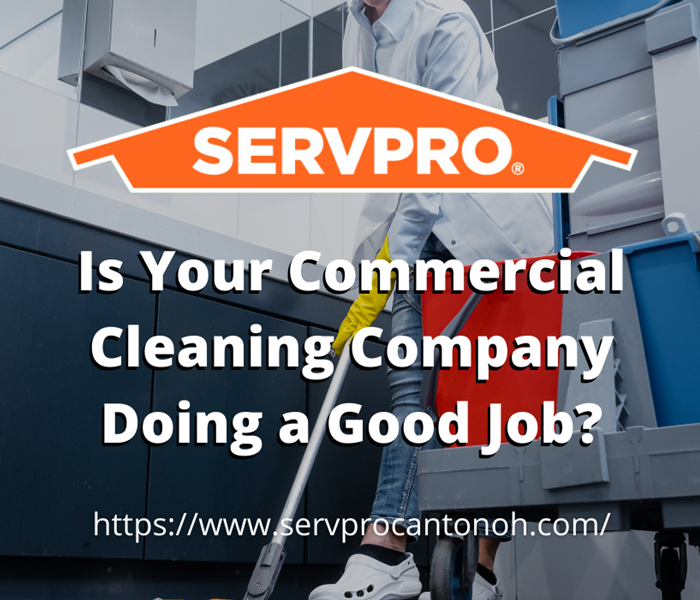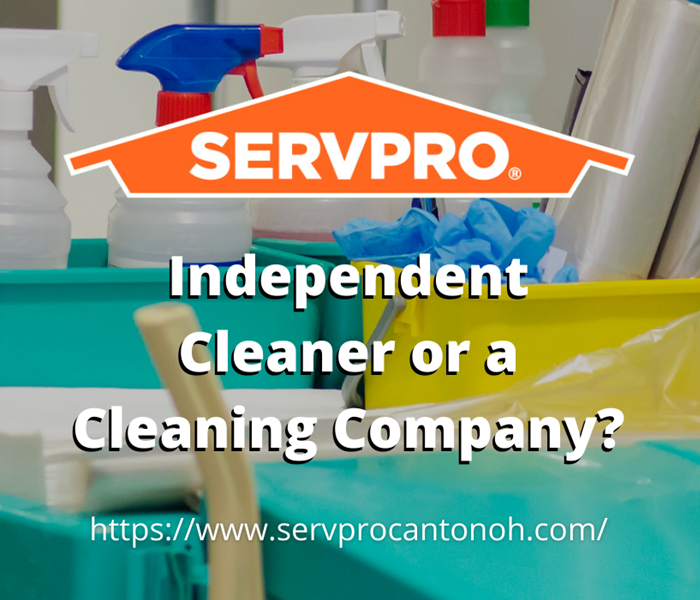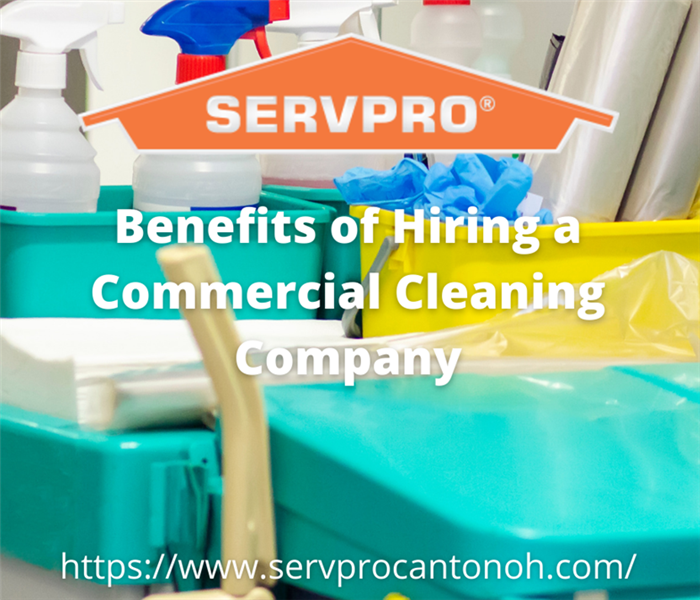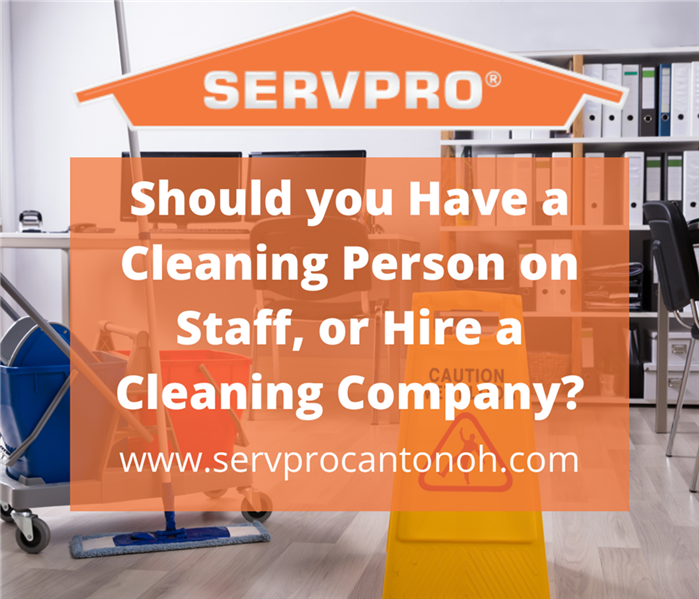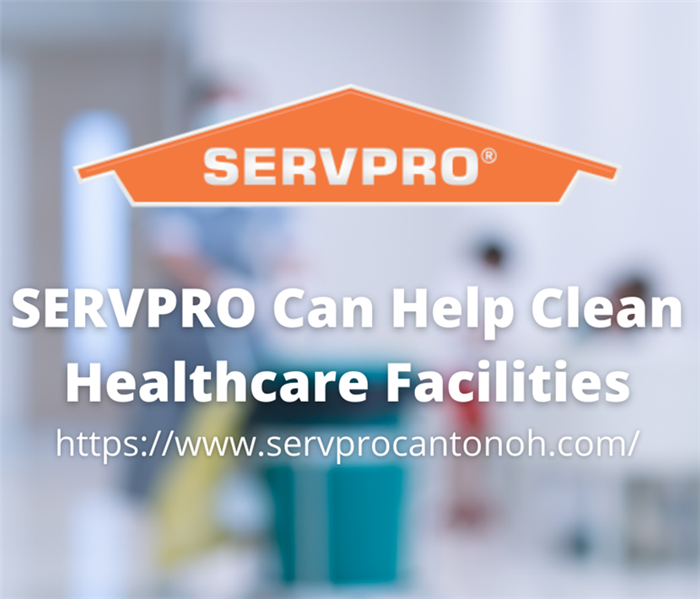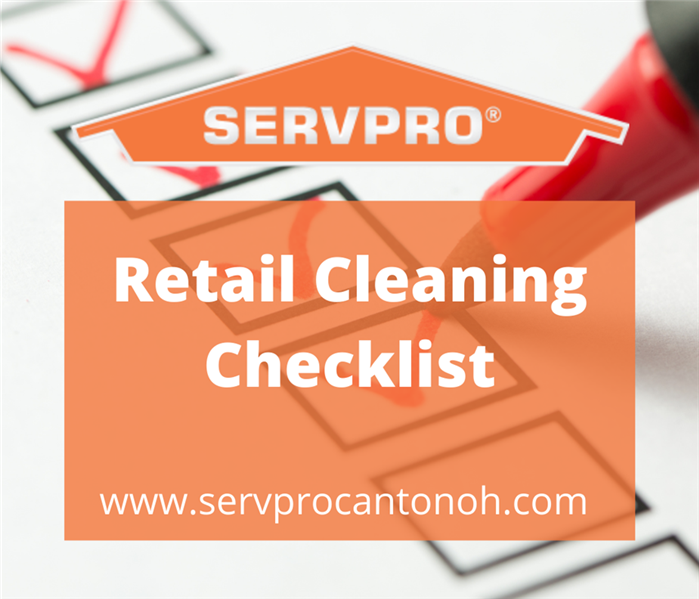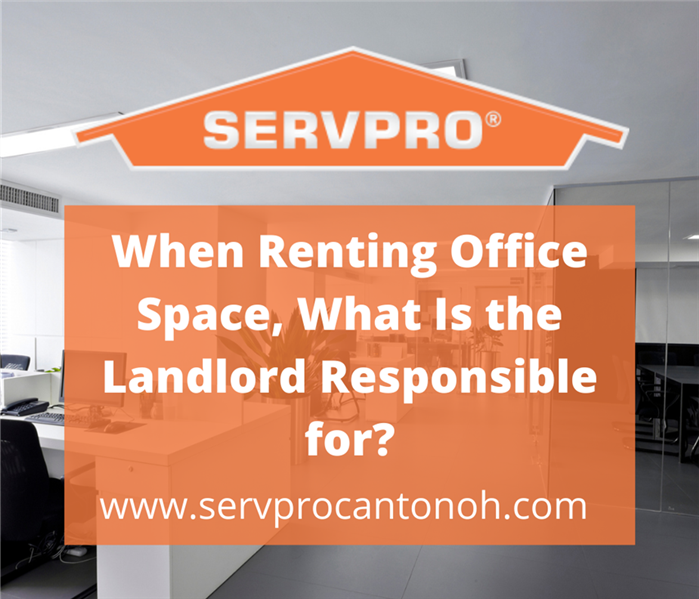Recent Commercial Posts
What a Good Emergency Ready Plan Will Look Like For Your Business
7/27/2022 (Permalink)
Emergency Ready Plans are the best way to prevent any disasters from happening in your business and are a great way to be one step ahead of any mishaps. Our SERVPRO Emergency Ready Plan is a great way to make sure your business is staying proactive in situations where you will need some cushion. This plan includes many advantages and will be beneficial in the long run for your business.
A No-Cost Assessment of Your Facility
No need to allocate funds, giving you great value at no cost.
A Concise Profile Document
It takes just a short time to complete the profile but could save long hours of time and effort if ever needed.
A Guide to Help You to Get Back Into Your Building
Having an immediate plan of action can help minimize the downtime to your business in an emergency.
Establishes Your Local SERVPRO As Your Disaster Mitigation
You have a provider that is recognized as an industry leader and is close by.
Identification of the Line of Command
You can save time and money as we begin the work of mitigating the damage.
Provides Facility Details
Such as shut-off valve locations, priority areas, and priority contact information. You’ll have a quick reference of what to do, how to do it, and who to call ahead of an emergency.
Easier Insurance Claims Process
SERVPRO will help you navigate the insurance claims process and coordinate the necessary paperwork for a quicker, easier experience.
How Do You Know Your Commercial Cleaning Company Is Doing a Good Job?
2/2/2022 (Permalink)
As a business owner or property owner, you have so much going on at all times that performing quality control on your hired cleaning company often doesn’t happen. Unless you notice an issue.
But the truth is, quality control shouldn’t be your responsibility. It’s the responsibility of the cleaning company. So how do you know if the cleaning company you’ve hired is doing a good job? Here are some details to look for.
It’s all about the details
You want a cleaning company that pays attention to detail. Because it’s usually the details that a cleaning company misses that alert you or your employees. For example, you notice dust building up on window sills or in corners, restroom counters not wiped down thoroughly, or sections of flooring unswept or mopped. After a professional cleaning company treats your premises, you should be able to perform your job without noticing anything.
Timing matters
Your cleaning company should not interfere with your business operations. If a cleaning crew limits or inconveniences your clients, then there is a problem. Cleaning crews typically clean outside of business hours or during the slowest times of the day. Again, if you notice the cleaning company, that could be a problem.
When you hire a good cleaning company, you should rarely notice them or any dirt, grime, or odors in your workspace. If you need a professional cleaning and restoration company, look no further than your local SERVPRO. We have 1,700 franchises across the nation, and we’re open 24/7!
Should You Hire an Independent Cleaner or a Cleaning Company?
2/2/2022 (Permalink)
Are you trying to decide whether you should hire an independent cleaner or a cleaning company? It’s an important question to consider, and we’re here to give you some guidance to help you make an informed decision.
When you hire a cleaning company, you’re getting professional cleaners who have been vetted, hired, and trained by the company. You can rest assured that whoever cleans your facilities is an employee of the company you’ve hired. If your usual cleaner is sick or on vacation, the company will assign another competent cleaner to your facility.
When working with a company, all you need to worry about is paying the company, which will provide you with an invoice. If anything is broken, stolen, or the cleaner is injured, the cleaning company will cover the damages or workman’s compensation. If there is an issue with a cleaner, the company can speak with them, and, if necessary, assign a new cleaner to your account.
On the other hand, if you hire an independent cleaner, the process is more complicated and can be uncomfortable when issues arise. For example, if you hire an independent cleaner, they may not be properly trained or have all of the necessary supplies to clean your space. You also can’t rely on a company to do a background check and vet them. It’s up to you to do the research or take on the risk. If the cleaner becomes sick or takes a vacation, your space does not get cleaned until they return to work.
If anything is lost, stolen, or broken, you will have to speak to the cleaner yourself or file a police report, which can be very uncomfortable. If the cleaner is injured on the job, and they’re not insured, you could be held liable. And if you're not happy with the cleaner’s services, you have to have those uncomfortable conversations.
If you’re interested in hiring a top-shelf cleaning company, look no further than SERVPRO. With 1,700 franchises nationwide and 24/7 availability, you can count on a job that meets our high standards and is completed on time.
The Benefits of Hiring a Commercial Cleaning Company
1/25/2022 (Permalink)
Some people have concerns about hiring a commercial cleaning company. But most of those concerns are based on false information. In this post, we’ll look at some of those base-less concerns and some of the many benefits of hiring a professional cleaning company.
Concern #1: Cleaning companies are impersonal
Some people think hiring an independent cleaner is better because you know them or are more likely to get to know them. They feel that cleaning companies are big, faceless entities, and are, therefore, harder to trust.
This really isn’t the case. Employees of professional cleaning companies are just as friendly as independent cleaners. And while having one cleaner you can call your own sounds nice at first, it can actually cause issues. For example, what if your cleaner wants to take a vacation or becomes ill. Your facility doesn’t get cleaned. With a cleaning company, if your normal cleaner isn’t available for whatever reason, the company will send another cleaner to make sure you get the services you’re paying for.
Concern #2: Independent cleaners do a better job than companies
These days, we’ve become distrustful of bigger organizations like companies and governments. While this distrust is sometimes earned, it’s not always warranted. For example, you may think that an independent cleaner will do a better job than an employee of a cleaning company. But that independent cleaner is just as likely to slack off and cut corners. In fact, they may be more likely to cut corners because they don’t have to answer to a boss. An employee, on the other hand, must meet their company’s standards in order to keep their job. There’s also the question of supplies. A cleaning company has a steady stream of cleaning equipment and supplies. An independent cleaner may not be able to afford such equipment
Concern #3: Handling issues with quality of work
Many people assume that when they hire an independent cleaner, the quality of work will be better than that of a cleaning company. This is often untrue and puts the person employing the cleaner in an awkward position. If the independent cleaner isn’t doing quality work, then it’s up to the employer to speak to that cleaner. These conversations can be uncomfortable and can lead to resentment. However, if you’re working with a cleaning company, and you’re unhappy with the outcome, most cleaning companies have channels in place where you can express your concerns. Fixing the issue then falls on the employee’s supervisor. Also, if you are unhappy with your service, most companies have money back guarantees.
When you work with SERVPRO, you’re actually working with a franchise of a larger company. And the franchises are each unique and want to build relationships with the people they serve in their community. Reach out to your local SERVPRO family for any questions about our professional cleaning services.
We look forward to speaking with you!
Should you Have a Cleaner on Staff, or Hire a Cleaning Company?
1/4/2022 (Permalink)
Offices can be a common place that begin to foster viruses and other germs. This means that it is essential, especially in the current pandemic, that a company is properly adapted to be cleaned and sanitized regularly. This poses an important question: Should you have a cleaning person on staff or hire a cleaning company?
Typically, having a cleaning person on staff may seem to be the logical choice to many companies. The cleaning person will most likely be there on a daily basis and be able to clean during or after the workplace is being occupied. Most of the time, a cleaning person on staff will have a very limited knowledge on proper cleaning techniques, unlike a commercial cleaning company.
A commercial cleaning company is specialized in cleaning workspaces. They are trained on how to deeply and efficiently clean offices to minimize the chance of a virus from spreading. Hiring a professional cleaning company gives you the peace of mind that the safety of your staff is in highly qualified hands.
Having a quality clean to your office regularly will ensure that your employees are safe in their workplace. Due to the current state of the pandemic, it is of the utmost importance to keep your staff in a clean environment. Hiring a trusted commercial cleaning service, such as SERVPRO, is vital to keep your community safe.
SERVPRO Can Help Clean Healthcare Facilities
12/21/2021 (Permalink)
Disasters in healthcare facilities are devastating to patients, employees, and the property owners. In an emergency, keeping the patients safe is the priority. Damage to the property is inevitable, so it is important that the people are the most important asset in the situation. If there is any damage to the property, it is vital that you contact a damage restoration professional, such as SERVPRO.
Once you have created a plan that allows your patients and staff to get to a safe point, asking for help from a restoration specialist is key. SERVPRO is capable of cleaning up any damage caused by disaster, such as fire, storm, or water damage. We make the process as seamless as possible. In turn, this helps the patients and staff get back into the building as soon as it is safe to do so. Ensuring that your healthcare property is in good hands is key to getting your building in tip top shape for optimal performance.
SERVPRO is also a top notch cleaning service for healthcare facilities. From medical offices to hospitals, we are trained to deliver the best quality cleaning. SERVPRO adheres to HIPPA protocols and properly disposes of medical waste. Proper cleaning in medical facilities is necessary to keep anyone that enters the building as safe as possible.
SERVPRO is committed to providing everyone with clean and safe healthcare environments. Professional restoration and cleaning services are essential to keeping your healthcare facilities as sanitary and safe as possible. Contact SERVPRO today to learn more about our medical facility cleaning and restoration.
Retail Cleaning Checklist
9/6/2021 (Permalink)
COVID has forced retailers to adapt in many ways remarkably quickly. And while it’s certainly been a difficult time and the future remains uncertain, it’s also been an eye-opening experience for changes that may be long overdue.
When it comes to store cleanliness, COVID has perhaps pushed businesses in a good direction, pandemic notwithstanding. It’s important to pay extra attention to the details. Creating a thorough retail cleaning checklist is absolutely essential so that nothing is forgotten and to keep your entire team on the same page.
Retail Cleaning Checklist:
- Clean High-Touch Surfaces Often - The most important parts of your store that need cleaning are the spots the get high traffic of touches. Of course, these are the areas that are most likely to pass a virus or other germs from one person to the next. For retailers, these likely include; Doorknobs and handles, Counter surfaces, Bathroom doors, Sinks and toilets, Shopping baskets and carts, POS machines, and credit card pin pads.
- Disinfect Properly - There are many different solutions that work as a disinfectant. First, make sure to use soap and water before disinfecting. This helps reduce the dirt and grime beforehand, making the disinfecting round more productive.
- Wash Soft Surfaces - Clean all carpets, rugs, chairs, couches, window drapes, towels, and apparel tried on by a shopper. Use soap and water or any other disinfectant cleaner on larger items to clean them and preserve their appearance. For small individual items, use a washing machine with hot water.
- Wipe Down all Electronics - Electronics are the most commonly touched items in any store, particularly around the point of sale area. Clean all POS hardware, including desktops, keyboards, scanners, tablets, credit card machines, receipt printers, keypads, and cash drawers. Many retailers have implemented a regular cleaning every 15-30 minutes.
- Don’t Forget Outdoor Areas - Outdoor areas are safer than indoors, but they, too, need attention. Do not spray outdoor areas with disinfectant. It’s not proven to reduce risks of transmission and a waste of the cleaning material. Clean areas that are routinely touched with soap and water, such as railings, outdoor seating areas, sidewalk signage, or anything else at your storefront that can come into contact with customers or passersby.
- Make all Retail Cleaning Checklists a Habit - As important as the items in the checklist itself, it’s critical that businesses implement a routine for their staff. Like mask-wearing, more frequent hand washing, or any other change we’ve had to make to adapt to the pandemic, changing your store’s policies requires that your staff find a habit. Start with a general staff meeting to go over a cohesive policy. Put the new policy in print so that all team members can access it and it can be shared with new employees.
Post checklists in opportune spots around the store. Ask shift leaders and managers to double-check with staff members throughout and at the end of their shifts, especially during the beginning.
SERVPRO offers commercial cleaning services backed by over 50 years of experience. They are knowledgeable and certified to ensure sanitation in line with CDC guidelines. Let us worry about the dirty work, call 1-800-SERVPRO today for a consultation.
When Renting Office Space, What Is the Landlord Responsible for?
9/6/2021 (Permalink)
When you’re renting commercial office space, it’s crucial to have a strong understanding of what your landlord is responsible for. You don’t want to spend money on services that aren’t your responsibility. And you also don’t want to cause further damage to anything that you should not tamper with in the first place. This could be a transgression of your rental agreement and could lead to legal recourse.
With that said, you should always check your rental agreement or lease contract. Have a copy on hand that you can reference when you’re unsure which responsibilities belong to you and which to your landlord.
Generally, there are a number of aspects your landlord is responsible for. Structural repairs usually fall on the landlord. It’s the landlord’s responsibility to maintain and repair heating, ventilation, and air-conditioning, as well as plumbing and electrical.
If there are any systems or machinery that come with the space, those usually fall under the landlord’s responsibility as well. In addition, your landlord is usually responsible for keeping common areas like stairways and elevators clean and functioning properly.
If your lease contract does not specifically state these matters, then it’s worth having a discussion about. Otherwise, you could be held liable for building repairs that you’re not insured to cover.
Whether you are a landlord or tenant in a commercial space, keeping your property clean and safe is important. If you need help cleaning and maintaining your commercial space, don’t hesitate to reach out to SERVPRO. Our trained professionals are there to help your business succeed.
Let SERVPRO Be Your Trusted Building Maintenance Partner
7/8/2021 (Permalink)
As a business owner or property manager, your plate is full enough. There aren’t enough hours in the day for you to complete your top-priority tasks and clean your facility. Or maybe you have a cleaning crew, but you’re not satisfied with their work.
As America’s #1 cleanup and restoration brand, we provide professional cleaning to commercial offices and industrial facilities.
Since COVID-19, cleanliness has become a top priority for everyone. Business owners know their customers expect the highest level of cleanliness for their safety. So if a workplace is dirty, has odors, unwanted moisture, or shows signs of normal wear and tear, customers and employees may feel unsafe. We’re here to help you keep your space looking and smelling new.
If you want to raise the standards of clean, we offer Certified: SERVPRO Cleaned. This program targets viral pathogens to prevent the spread of COVID-19. This service is geared to the unique needs of each space and includes a professional deep cleaning using our EPA-approved, hospital-grade cleaning agent.
When your customers and employees see the Certified: SERVPRO Cleaned shield on your business’s window, they’ll feel safe and welcomed.
Your local SERVPRO franchise wants to take building maintenance off your plate and give you the best professionally cleaned workspace they can. That way you can focus on the things only you can do.
Deep Cleaning Your Office - How Often, and What Does it Really Entail?
4/5/2021 (Permalink)
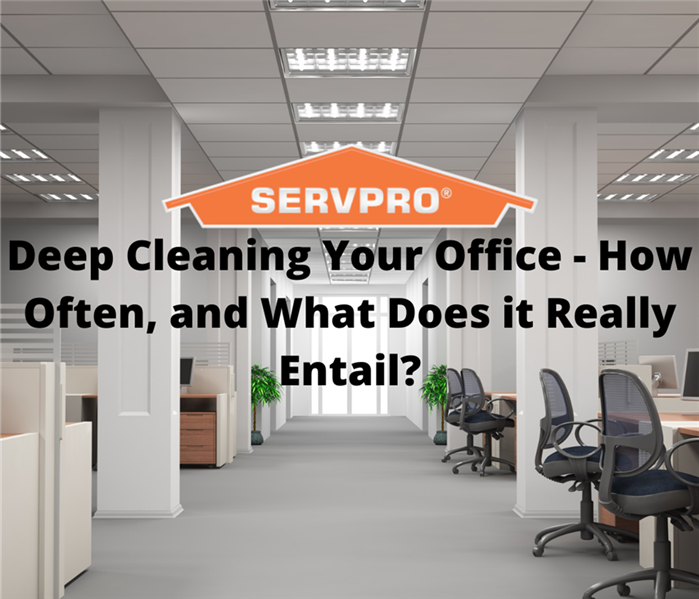 Make sure your office is up to the cleaning standards for you and your employees.
Make sure your office is up to the cleaning standards for you and your employees.
Blooming flowers, cute springtime outfits, warmer weather, sunshine, and no more snow! Spring is here and so many wonderful things come along with the season. But there is one aspect that is dreaded. Spring Cleaning. When it comes to your office keeping it clean is so important for both your employees and your customers. Cleaning the office regularly reduces the number of harmful germs and bacteria present. Fewer sick days mean more productivity. And speaking of productivity, a clean office is clear of distractions and obstacles that make work more cumbersome.
COVID-19 has changed so much about how we live and do business, including how deeply and how often office cleaning is recommended. Deep cleaning is important, especially if you suspect or have confirmed a COVID-19 case in your workplace. Deep cleaning in the office revitalizes your workspace by going further than the normal weekly cleaning procedures.
General Deep Cleaning Services:
- Carpets and upholstery are cleaned and treated to remove stains.
- Draperies, blinds, and window treatments are vacuumed, dusted, and cleaned.
- Wood, tile, ceramic, or cement flooring is thoroughly scrubbed, stains are removed, and flooring is either refinished or sealed.
- Air ducts are vacuumed and filters are cleaned or replaced.
- Tile grout is cleaned thoroughly to remove stains and grime.
- Computer keyboards, monitors, phones, copy machines, and other items are cleaned and sanitized.
When to Schedule?
On average, an office with light traffic or few employees may need a deep clean once or twice a year. Medium traffic may need a bit more attention; twice a year or every other month. However, carpeted offices with heavy traffic may need deep cleaning as frequently as once a month. Regardless of your office’s size, a deep cleaning can be done any time of the year. With the current going-on in the world, you also need to deep clean after any COVID-19 outbreaks.
There is nothing more important than keeping yourself, your employees, and your customers safe, now more than ever. SERVPRO understands this and developed Certified: SERVPRO Cleaned defensive cleaning program that gives your business a way forward to provide your employees and customers ongoing safety as you operate after the COVID-19 pandemic. Find out more today and get that dreaded spring cleaning out of your hands.
Preserving a Historical Building
2/26/2021 (Permalink)
Building repairs, updates, and general maintenance can be taxing both physically and mentally. This is especially true when it comes to a historical building. Not only do you have to worry about guidelines and restrictions, but the building may also be a little more fragile than a structure that has been built in the past few decades. So, how exactly do you go about caring for and preserving a historical building without compromising the safety of its occupants? A good place to start is to understand the cultural significance of the structure and the history it holds.
Once you truly understand the structure’s story, it becomes easier to have direction in preserving and protecting it. In fact, depending on the significance of the building, you may be able to apply for grants and funding to help maintain and update the structure. If you are able to secure these, you can truly make the commitment to not cut any corners on supplies or experience. This will be an important factor not only for the safety of everyone, but also maintaining the most accurate image of the building.
If you have found yourself in possession of a historical building, take time to consider and do your research. Resources ARE available, and you may be surprised by how important preservation is to others who may be willing to help. You do not have to restore and preserve it all on your own, and you will be grateful you saved a piece of history when you do! If you find that you need a little extra help cleaning and sanitizing your building, give SERVPRO a call at (330) 677-4483 for help with all of your commercial cleaning needs!
Office Rental Maintenance: Who is Responsible for What
2/5/2021 (Permalink)
 Educate yourself on the responsibilities of you versus your landlord.
Educate yourself on the responsibilities of you versus your landlord.
Office rental maintenance relies on an agreement between the tenant and the landlord. Although these agreements can differ from one to another, they often follow many of the same basic principles. As a general rule of thumb, the tenant is responsible for keeping the office in good shape and the landlord is responsible for the structural aspects of the building.
The responsibilities of the tenant are focused on many of the cosmetic aspects of the rental space. This includes the cleaning and repairs of items such as the carpet, wall coverings (such as paint or wallpaper), lighting, and bathroom and kitchen fixtures. As the tenant, your responsibility is to fix any of these aspects of your rental office if you cause damage to them.
The landlord of the rental aspect is in charge of the structural integrity of the rental office. Some structural aspects are the shell of the building, the foundation, windows, roofing, electrical system, heating system, and ventilation system of the building. These responsibilities many landlords do not want to put in the hands of their tenants because they want to assure that they are maintained and repaired properly.
There needs to be a good balance between tenant and landlord responsibilities. For example, a tenant of the office space may not want to invest much money or effort into fixing the electrical system of the building because they are only renting the space and do not have any commitment to staying in the office space forever. Cutting corners on repairs of major systems of the building can be unsafe. On the other hand, if a lightbulb burns out, the tenant will be much more willing to repair it because it is a simple and inexpensive problem to fix.
Responsibility in rental office maintenance is something that needs to be addressed when signing a lease. Both parties must agree on the terms of the lease. If you need to address any repairs, make sure you contact a professional. SERVPRO of Canton is always ready to help whenever you are in need of a repair.
COVID-19 Cleaning - What Makes a Difference?
1/4/2021 (Permalink)
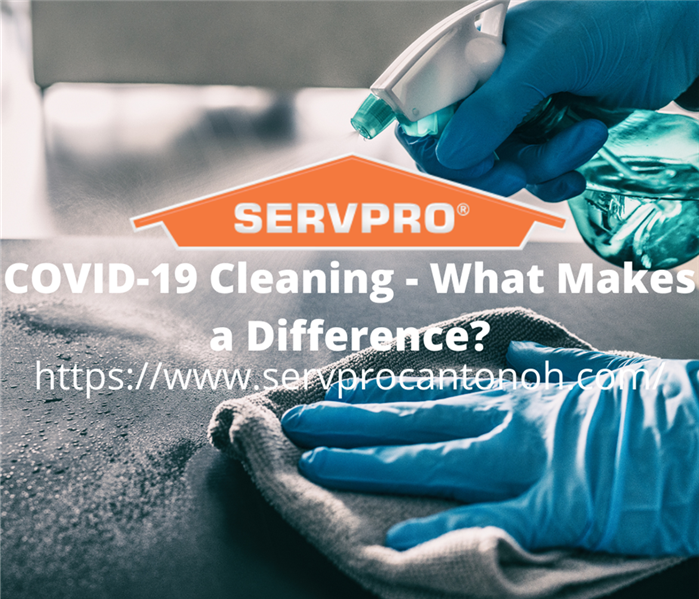 Prevent the spread of COVID in your business with SERVPRO Canton.
Prevent the spread of COVID in your business with SERVPRO Canton.
COVID-19 Cleaning - What Makes a Difference?
The pandemic has changed many of our routines and lifestyle choices; one of the most notable being our cleaning habits and protocols. COVID has proved itself as a force to be reckoned with in terms of its spread and lethality. One of the main things this virus has shown us is that we have been living in a world filled with lackluster cleaning.
Firstly, it is essential to note the difference between cleaning, sanitizing, and disinfecting and the best use for each of them:
Cleaning is the process of removing dirt and bacteria, not necessarily alienating them. This should be performed on surfaces routinely throughout the day. Make sure your employees are washing their hands frequently and adequately.
Disinfecting is actively killing germs that are on surfaces, this should be done when bacteria is found or suspected on a specific surface.
Sanitizing is the process of using both actions to cut down the number of germs on surfaces.
So, What Works Best?
Whether it is at your business or at home, you will want to make sure you are cleaning all high touch surfaces, these include:
- Keyboards
- Remotes
- Desktop Mice
- Tables
- Doorknobs
- Handles
- Toilets
- Faucets
- Railings
These frequently trafficked areas should be cleaned at least 3 or more times per day to ensure the limitation of spreading the virus and/or other harmful bacteria. Call your trusted SERVPRO to get the job done right and keep your company safe.
Tips for Keeping Employees Safe and Healthy this Winter
12/2/2020 (Permalink)
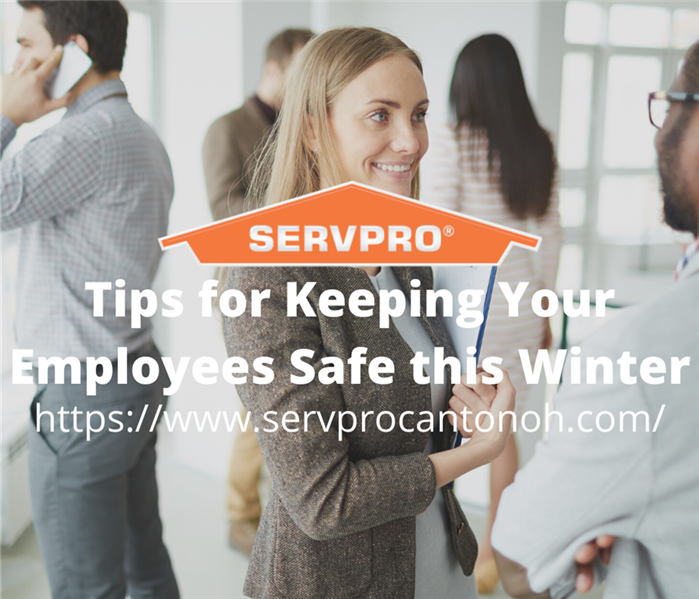 Your employees are one of the most important parts of your business, make sure they are staying safe from the winter blues.
Your employees are one of the most important parts of your business, make sure they are staying safe from the winter blues.
The winter season is full of dangers as well as illnesses. This winter, however, we are dealing with more worries than we have had to in the past. This is because winter is already known as flu season and is being impacted even more this year due to covid. It is more important than ever to keep employees safe and healthy this winter season, and we can help with these tips.
In the winter there are many weather elements that can cause a lot of harm to a person. There are dangerous things such as snow, ice, and even frigid temperatures. Some ways to help ensure your employees are safe in these conditions are by keeping all the walkways and work areas clear of ice and snow by shoveling and salting the ground. If in a constant outdoor work area it could also help to have heavy-duty shoes with good traction on the bottom and protection for the winter weather. Another thing to ensure the safety of employees whether working outdoors or indoors is to have them wear bright-colored clothing (vest, etc.), especially when they are outside in winter weather because snow may make it difficult to see someone.
Getting sick is a common occurrence in the winter months. People become ill in many different ways and it may be hard to avoid it in the workplace. The best way to keep workers healthy is to have employees feeling sick to stay home when ill. Especially with covid, it is important to have employees always wearing masks or to have employees work remotely and minimize the number of people in a workspace.
It is important to keep your employees safe and healthy while working. We are here to help you keep employees safe in your workplace. Contact SERVPRO of Canton today and get the services you need to ensure the safety and health of your employees.
Your Business Needs a Contigency Plan
9/24/2020 (Permalink)
 Make sure that you know what you'll do if disaster strikes your business.
Make sure that you know what you'll do if disaster strikes your business.
Every business wants to avoid all possibilities of something going wrong, but sometimes disaster is unavoidable. The way a company chooses to cope with the disaster is up to them, but it will always be in their best interest to have a contingency plan in place in case disaster strikes. There are several steps any company should consider when creating their own business contingency plan.
- Assess What Threats There Are To Your Company
No matter what industry a business is in, there will always be threats to the business. The most common threats are natural disasters. This could include fires, storms, floods, earthquakes, tornadoes, or hurricanes. The threats your company is susceptible to are based on your location.
- Decide How Employees Will Communicate
Communication is key whether there is a disaster or not. Having your employees communicate properly during a crisis will allow your business to remain operational. Your employees will feel more comfortable knowing how they are going to communicate with their coworkers during an emergency.
- Choose Where Employees Will Go
Going to the office is almost a comfort to many people. They know that is where they are the most productive in getting work done. Disaster can take that away. You must choose a spot that your employees will feel safe to get their work done, even though it may not be their typical workplace.
- Determine How Employees Will Continue To Do Their Jobs
Even in a disaster, work will still need to get done. Deciding how your employees will get done will be easier for some companies than it is for others. The internet has opened an abundance of doors to get work done in different locations, but that may not always be an option for everyone. The key is to find a plan that will keep your employees as productive as possible.
Now that you have a plan in place, there is only one way to see if it will be effective: test it out. There are several ways to go about this. Primarily, you could walk through the plan with your employees and explain it to them as you go along. Another way you could have your employees test the plan is to have them perform a simulation. After testing your plan you can adjust things as needed.
Having a business contingency plan is crucial as an emergency could arise at any time. Not only is it crucial to consider how your business is going to operate after there is a disaster, but you also need to consider how your company is going to be able to return to normal. This may include fire/water/storm restoration to your workplace, having backup equipment, and making sure your employees are comfortable. Nobody wants their business to go through any type of disaster, but it is always best to be prepared for the worst.
Fire Damage Restoration of a Commercial Property
9/17/2020 (Permalink)
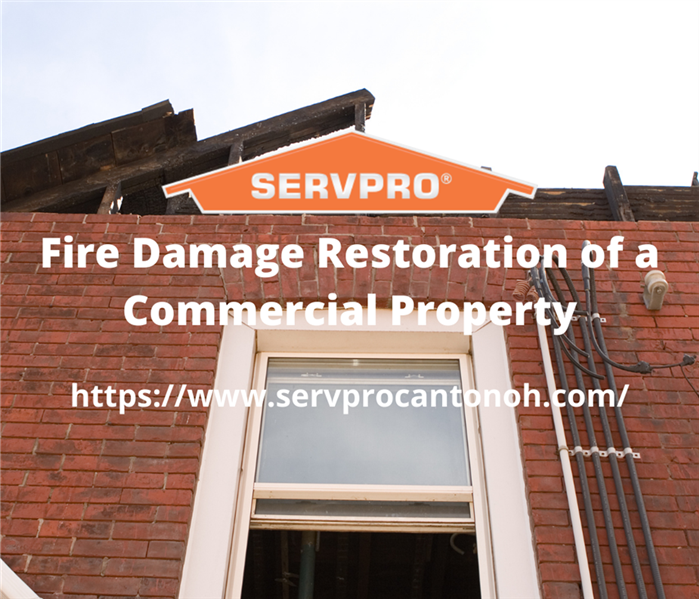 If a fire happens at your commercial property, you'll want the best in the business to make it right fast.
If a fire happens at your commercial property, you'll want the best in the business to make it right fast.
Whether you own a business or a commercial property, you might think that your building is invincible. However, whatever building it is from the traditional wood frame to brick and mortar, it is not invincible. Fire and other natural disasters happen, and when they do they are completely out of our control. As a business owner, a calamity such as this can be detrimental. You will likely have to shut your doors for repairs, and safety.
In the event of such a disaster, it will be important to act swiftly. This might be the time to consider a professional restoration service, not only for the safety of yourself but your employees and customers as well. Because a disaster can happen anytime day or night, a credible company will offer 24/7 services (yes, even on holidays). Whatever the time of day, it is important to take this five-step process to mitigate any further loss and guarantee a safe return.
ICE
Most of us have an “In Case of Emergency” contact saved in our phones, whether that be a spouse, friend, parent, or sibling. If you are a business owner, why not save your trusted restoration company’s number for events such as this. You should be proactive and call the company as soon as you can.
Evaluation
Once the crew has arrived, they will begin to assess the damage. At this time, it will be important to learn about what happened, and what locations of your business were affected. Once this has been done, you will receive a quote for the work that needs to be done.
Alleviation
At this time, the professionals will come in and get to work. They will close off areas that may have been affected, air out the space, and remove any damaged property and litter. This is a crucial step to avoid further damage.
Restore
The team will begin a full cleanup. This is when surfaces are cleared and sanitized of any soot, dust, smoke, water, and any other residue from the disaster.
Rehabilitation
The final step in the process is the full restoration and rehabilitation of your business. Anything that was damaged such as building materials, cabinets, carpets, electronics, furniture, and flooring will be taken care of.
As a business owner, after enduring a calamity such as this, it is understandable that you would want to save the most that you can. At times like this, we like to think that handling it ourselves is the best idea. This is not always the time and money saver that you hope it would be. It is not uncommon for these kinds of projects to be done improperly, create more damage, and end up costing more.
In situations like this, hiring a professional might be the financially savvy thing to do, plus you get peace of mind that the job is done right. When you call SERVPRO, you can feel at ease knowing that your business will be certified SERVPRO cleaned. Not only are we faster to any disaster, but we also adhere to the cleaning and decontamination standards set by the CDC. If you are faced with a disaster and need restoration services give SERVPRO of Canton a call at (330) 966-2377.
A Trained Team is Important for Your Small Business Restoration
7/17/2020 (Permalink)
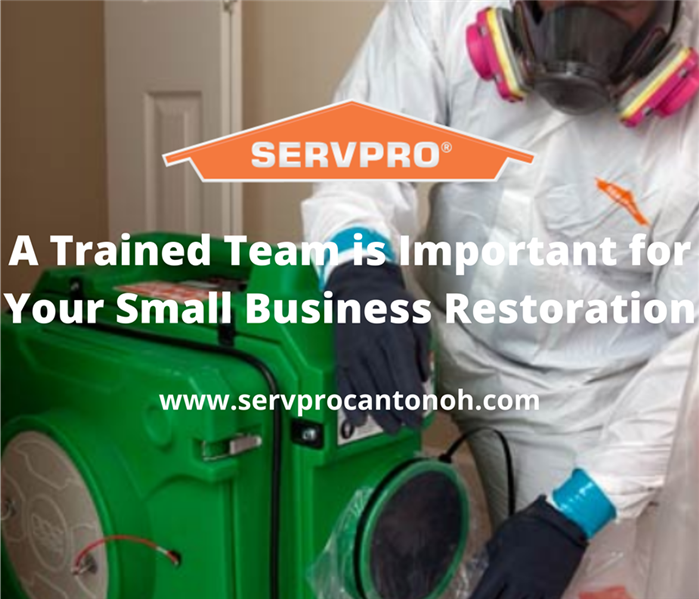 Our team knows what they're doing and can help you get back to business in less time.
Our team knows what they're doing and can help you get back to business in less time.
No matter where disaster happens, it can ruin lives. If fire, water, or storm damage strikes in your home, you can lose treasured possessions as well as have the comfort of your safe space majorly disturbed. For most people, they can’t imagine a worse situation to have to deal with. If you are a business owner, however, disaster striking in your business can be just as devastating as it can entirely disrupt your livelihood. Big corporations might be able to withstand an unfortunate event like a fire or a flood, but these situations could bring down a small business swiftly.
That’s why it’s important for business owners to have a trusted partner for restoration needs. We at SERVPRO of Canton hope that you never have to call on us but in your time of need, you should know that we will be there to answer the call. Our restoration technicians are on-call 24/7/365, prepared to step up to the plate and help you through the worst situations. Our team is trained with the best certifications available for restoration specialists and can be trusted with the things you value.
With the SERVPRO of Canton team, you will lose less of your valuable time to the restoration process and be able to resume business as usual quickly. We guarantee our work to be of the highest quality so you know that you can resume business after a disaster with no worries. If you’re a small business owner in the Canton area, make sure that you have our number saves so that you don’t lose any time searching for a restoration team when disaster strikes. Call SERVPRO of Canton at (330) 966-2377.
Would Your Business Be Ready For a Disaster?
4/2/2020 (Permalink)
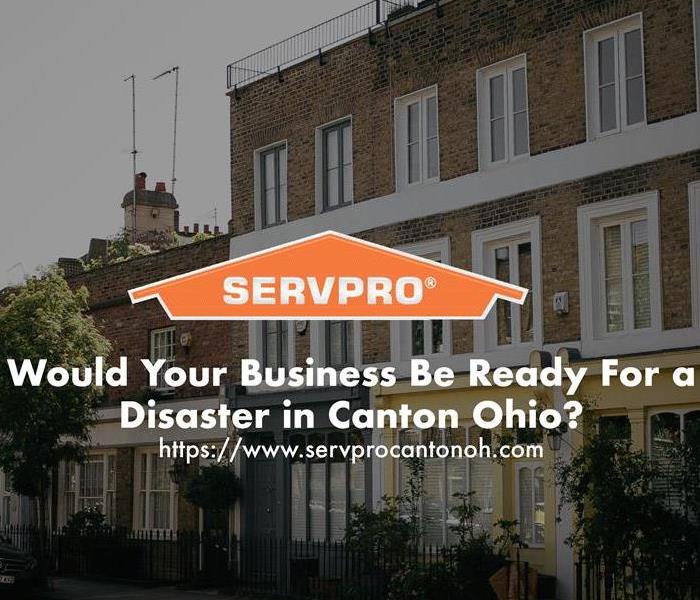 And now with the SERVPRO Ready Plan Mobile App, help is at your fingertips. Call now and ask how to get started.
And now with the SERVPRO Ready Plan Mobile App, help is at your fingertips. Call now and ask how to get started.
When disaster strikes, getting help is quicker and easier than ever before, by using the SERVPRO Ready Plan.
The best way to reduce business interruption following a disaster is to PLAN for it NOW. You never know when disaster will strike for your business.
The statistics uncovered by industry research say as many as 50% of businesses may never recover following a disaster, this is because those businesses never had a preparedness plan in place.
SERVPRO's Emergency Ready Profile for YOUR business will minimize business interruption by having an immediate plan of action. This is a no-cost assessment of your facility. It covers your emergency contacts, all shut-off valves and their locations, priority areas of your facility and more.
The SERVPRO Ready Plan provides solutions so that during the emergency you are "Ready for whatever happens."
And now with the SERVPRO Ready Plan Mobile App, help is at your fingertips. Call now and ask how to get started. A quick response time can reduce the overall costs and loss of use for your business. We are ready when you need us at SERVPRO of Canton. Call anytime: (330) 305-2650 any time of the day, someone is waiting to discuss your unique situation and help you determine the best course of action.
Prevent Damage To Your Business in Canton Ohio
2/1/2020 (Permalink)
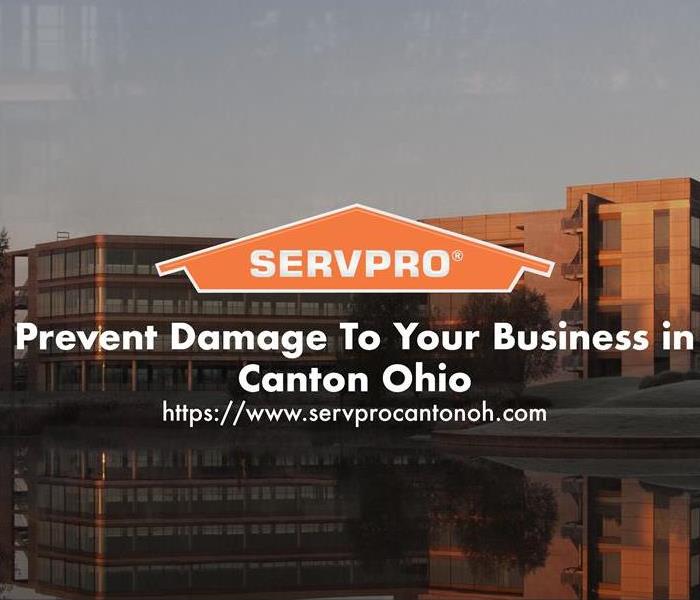 Implement an emergency plan and make sure employees know how to respond. You can set up an Emergency Plan Readiness with SERVPRO of Canton
Implement an emergency plan and make sure employees know how to respond. You can set up an Emergency Plan Readiness with SERVPRO of Canton
Prevent Damage To Your Business in Canton Ohio
Mother nature is unpredictable, and it can seriously impact your business. Not only can they damage the property and equipment, but it can prevent employees from getting to work. Here are some tips to reduce your risk of disaster damage:
- Backup your company files and store them in a safe, off-site location.
- In the event of a disaster, heavy equipment and cabinets, could topple over causing injury to those nearby; make sure all large items are pinned down nicely.
- If you are replacing the roof be sure to make them as fire-resistant as possible.
- Keep a fire extinguisher on every floor, this can prevent the fire from becoming more dangerous.
- Reinforce doors and windows to protect against strong forces.
- Have an emergency kit on hand and also a complete first aid kit.
- Implement an emergency plan and make sure employees know how to respond. You can set up an Emergency Plan Readiness with SERVPRO of Canton
Remember, a quick response time can reduce the overall costs and loss of use. We are ready when you need us at SERVPRO of Canton. Call anytime: (330) 305-2650 anytime of the day, someone is waiting to discuss your unique situation and help you determine the best course of action.
How to Avoid Wind Damage to Your Business In Canton Ohio
1/3/2020 (Permalink)
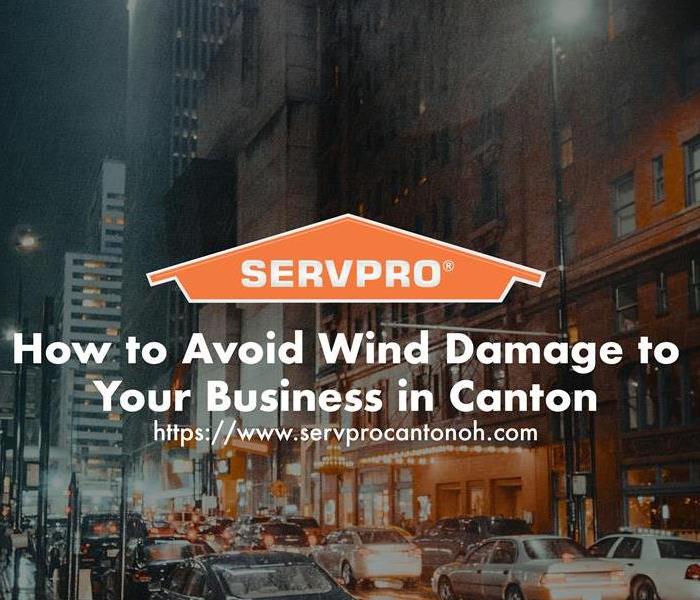 If you or someone you know is faced with wind damage and needs restoration, the experts at SERVPRO can help
If you or someone you know is faced with wind damage and needs restoration, the experts at SERVPRO can help
Winds from tornadoes and thunderstorms damage homes and even businesses in tragically ways. In fact, winds might not even be storm-driven but can still pack awesome force. This is simply because winds are powered by air moving from high atmospheric pressure areas to lower pressure areas.
Wind is uncontrolled and unpredictable, it’s a threat for many businesses. Here are a few preparation tips:
Ensure insurance coverage: It is important to discuss coverage for wind damage with your insurance company in advance of storm season. Many policies cover wind damage, but might have restrictions so it is important to know what is covered and to ask questions.
Prepare property: It is important to make sure that your building is sealed. You will also want to make sure your siding, windows, doors and exterior components are securely fastened.
Prepare surrounding environment: Wind harms property indirectly. Trimmed and healthy trees are less likely to drop limbs or even fall whenever a storm happens. Any outdoor structures are advised to be secured to the ground.
If you or someone you know is faced with wind damage and needs restoration, the experts at SERVPRO can help to mitigate the damage and restore your home! Call (330) 305-2650
Every Business Should Have An Emergency Kit.
12/2/2019 (Permalink)
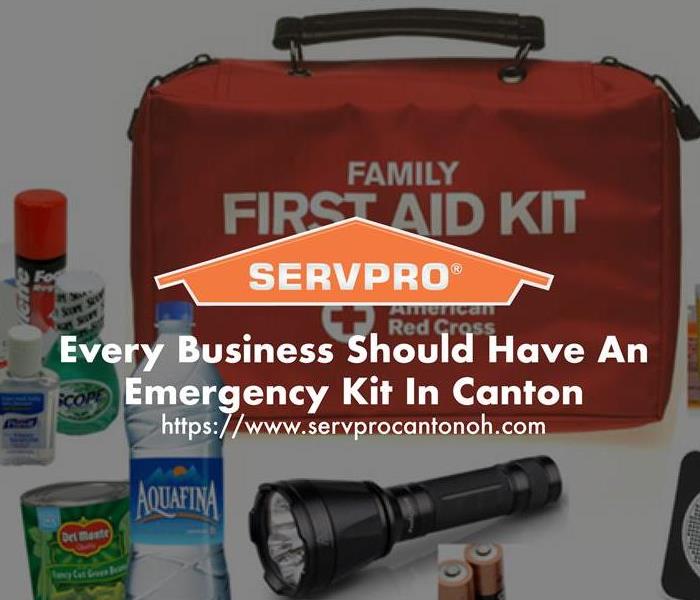 Disaster can strike at anytime for a business. It is important to make sure you can be as prepared as possible in case of a disaster.
Disaster can strike at anytime for a business. It is important to make sure you can be as prepared as possible in case of a disaster.
Disaster can strike at anytime for a business. It is important to make sure you can be as prepared as possible in case of a disaster. A business disaster kit should include emergency supplies for you and your employees to stay safe and well while waiting out the storm, and on ward.
So, what to put in an office emergency kit? Here is a list of items to consider when creating a business preparedness kit:
- Bottled water: Have a minimum three-day supply of water for every member of your staff. You need to have enough clean water for both drinking and sanitary purposes.
- Non-perishable food: You will want to have a three-day supply of non-perishable food per person. Keep in mind that the food should NOT require any cooking and should NOT provoke thirst. A few examples are canned meats, vegetables, and fruits; nuts, cereal bars and other food items that have a long shelf life.
- First-aid kit and essential medications: Sterile gauze pads, bandages, antiseptic lotion, pain relievers, fever reducers, thermometer, scissors, tweezers, and sterile gloves are just some ideas to start with.
- Sanitation and hygiene supplies: Hand soap, paper towels, moist towelettes, antibacterial wipes, toilet paper, garbage bags, disinfectants, and other hygiene supplies.
- Emergency supplies: Fire extinguishers, flashlights, light-sticks, spare batteries, whistles, a portable hand crank radio, and a disposable camera.
If your business you know is faced with a disaster and in need of restoration, the experts at SERVPRO can help to mitigate the damage and restore your home! Call (330) 305-2650
Storm Damage Can Cause Disasters to Local Businesses
10/4/2019 (Permalink)
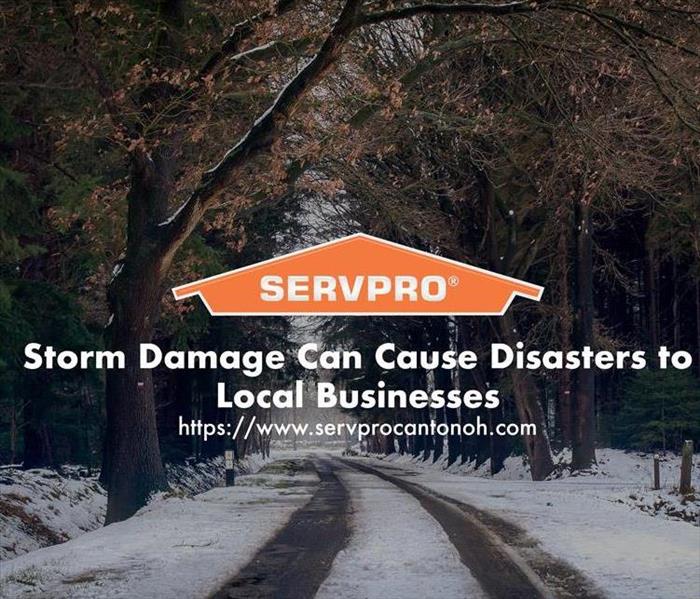 Winter storms that involve snow, rain, or even ice can cause damage to your business.
Winter storms that involve snow, rain, or even ice can cause damage to your business.
Winter storms that involve snow, rain, or even ice can cause damage to your business. It's prudent to take steps to prevent the dangerous effects of storm damage and to keep yourself and your employees safe. Winter storms can cause power outages that might last for days. They can make roads and walkways extremely dangerous. You can learn more at ready.gov/prepare.
Here are some quick tips to help you and your team prepare for a winter storm:
- Sign up for local alerts and warnings.
- Create and test emergency communication plan(s).
- Stock emergency supplies, and install battery-powered or battery backed-up carbon monoxide detectors and smoke detectors.
- Review your property insurance, and safeguard critical documents.
- Identify a place nearby where you can safely warm up should you lose heat in your business.
- Stay indoors and off the roads. If you must drive, keep emergency supplies in your car.
- Close off rooms to consolidate and retain heat.
- Dress in layers, and use blankets to stay warm.
- Never use a generator, camp stove, charcoal grill, or gasoline or propane heater indoors, as these items can start accidental fires, cause electric shock, and/or cause deadly carbon monoxide poisoning.
- Remove snow and ice from your tailpipe before starting your car, and check regularly if idling.
- Clean all snow and ice from your car before driving.
- Dress in warm clothing, stay dry, prevent prolonged exposure to cold and wind, and avoid overexertion clearing/shoveling snow.
If you are in need of restoration after this disaster give SERVPRO of Canton a call (330) 966-2377. We are open 24 hours 7 days a week.
Would Your Business in Canton Ohio Be Prepared for a Disaster?
10/4/2019 (Permalink)
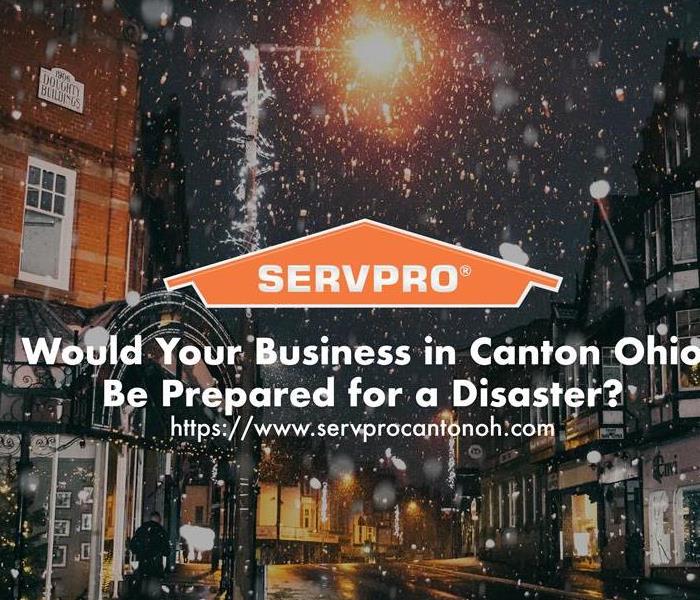 SERVPRO's Emergency Ready Profile for YOUR business will minimize business interruption by having an immediate plan of action.
SERVPRO's Emergency Ready Profile for YOUR business will minimize business interruption by having an immediate plan of action.
The best way to reduce business interruption following a disaster is to PLAN for it NOW. Up to 50% of businesses close down following a disaster, according to the latest research. Of the businesses that survive, the overwhelming majority of them had a preparedness plan
The statistics uncovered by industry research say as many as 50% of businesses may never recover following a disaster. Of the businesses that survive, the majority had a preparedness plan in place.
SERVPRO's Emergency Ready Profile for YOUR business will minimize business interruption by having an immediate plan of action. With a no cost assessment of your facility, the program's profile includes your emergency contacts, all shut off valves and their locations, priority areas of your facility and more. Here are some benefits of an Emergency Ready Profile
- A no-cost assessment of your facility. This means there is no need to allocate funds, giving you a great value at no cost.
- A concise Profile Document that contains only the critical information needed in the event of an emergency.
- A guide to help you get back into your building following a disaster. This can help minimize the amount of time your business is inactive by having an immediate plan of action.
- Establishes your local SERVPRO® Franchise Professional as your disaster mitigation and restoration provider. You have a provider that is recognized as an industry leader and close by.
- SERVPRO® is a sponsor of the American Red Cross Ready Rating™ program.
- A free, web-based program designed to help businesses, organizations and schools become better prepared for emergencies. Provides facility details such as shut-off valve locations, priority areas and priority contact information.
- Having a quick reference of what to do, how to do it and who to call provides solutions in advance of an emergency so that during the emergency you are “Ready for whatever happens.”
The SERVPRO Ready Plan provides solutions in advance of an emergency so that during the emergency you are "Ready for whatever happens."
Your business will receive the benefit of over 40 years of experience in reducing the impact of any natural or man-made disaster. Call now and take the next step in protecting and growing your business.
If you are in need of restoration after this disaster give SERVPRO of Canton a call (330) 966-2377. We are open 24 hours 7 days a week.
And now with the SERVPRO Ready Plan Mobile App, help is at your fingertips. Call now and ask how to get started.
Be Prepared With Your Emergency Ready Profile (ERP) in Canton
7/26/2019 (Permalink)
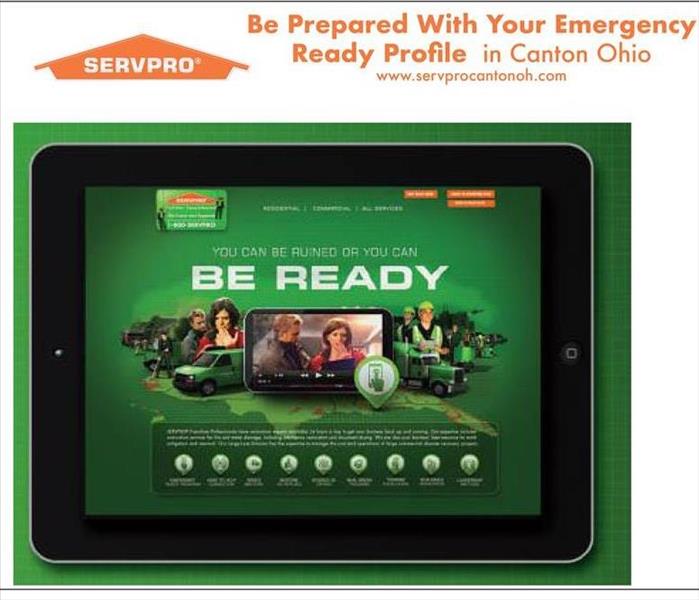 With SERVPRO's Emergency Ready Profile (ERP), you minimize business interruption by having an immediate plan of action at no cost.
With SERVPRO's Emergency Ready Profile (ERP), you minimize business interruption by having an immediate plan of action at no cost.
An Emergency Readiness Plan or Emergency Ready Profile is a method of careful, well-practiced strategy of planning for emergencies before they happen to prevent panic during a catastrophe. Having this tool in place will allow you or any employee to effectively handle whatever arises.
With SERVPRO's Emergency Ready Profile (ERP), you minimize business interruption by having an immediate plan of action at no cost.
What should your ERP contain? Besides the essential information such as emergency and primary contacts, gas and water shut-off areas, and priority areas and procedures, the Department of Homeland Security refers to your ERP as “Protective Actions for Life Safety” which includes:
- Fire Drills -- Rehearsing the action to take during a fire.
- Shelter -- Sheltering staff during a natural disaster.
- Shelter in Place -- Sheltering staff during a man-made emergency.
- Lockdown -- Eluding and protecting against an active shooter
With over 40 years of experience, you will have peace of mind using SERVPRO’s Emergency Ready Profile. Plus, our mobile app Ready Plan allows for instant share and quick accessibility for assistance. Rest assured, your business is in good hands when you trust SERVPRO and our highly, well-trained professionals.
SERVPRO's Emergency Ready Profile (ERP), you minimize business interruption by having an immediate plan of action.
Back to Basics: 6 Steps to Handle Large-Loss Fire Restoration
4/2/2019 (Permalink)
Not only can a fire be devastating for the structure of a home or building, but it can also be emotionally devastating when it comes to the occupants of that structure, whether that is a family of four or a company of 400 workers. That's part of the reason why handling a large-loss fire doesn't just involve restoring the property to a preloss condition, but also being sensitive and understanding with the occupants of the affected home or business. That's not to say that restoration professionals are counselors — they're not — but acting with empathy can go a long way toward making a fire loss a little less stressful for the individuals who are most impacted. Here are six steps to follow to handle large-loss fires:
- Getting the call: Whether this initial call comes from a homeowner or the insurance company, this first point of contact is an ideal time to gather as much information as possible about the fire. Where did it occur? How many rooms are affected? What type of fire was it? The goal of this initial point of contact is to gather information to get an idea of the scope of the project before arriving on site.
- Arrive on site/inspection: After the initial phone call comes an on-site inspection. This is typically done after the fire department has doused the flames and secured the property. By this point, the restoration team should have a good idea of what type of fire occurred (i.e. protein fire, petroleum fire, etc.) and inspecting the property helps team members estimate the scope of work that will be involved, the timeline of the project and whether or not any demolition and reconstruction will be necessary. Depending on the severity of the fire, the restoration team may also board up the windows and doors to ensure structural stability.
- Access occupant needs/packout: If it is possible, restoration professionals will likely ask the building occupants to gather any immediate needs. For a house fire, this may consist of undamaged clothes, school supplies, computers, etc. Everything else in the facility that has been affected by the fire will then likely be packed out and taken to an off-site location for contents restoration.
- Estimate and begin work: After estimating the cost of the project and having the proper documents signed by all parties involved, then work can start on the fire loss. For a large fire loss, demolition and reconstruction of at least a portion of the property is likely necessary. Other areas of the property may just require soot and smoke damage restoration, where walls are HEPA (high-efficiency particulate air) vacuumed and washed, items are hand-cleaned and carpets are deep cleaned to remove soot residue. While restoration is occurring on site, it's also likely occurring off site in terms of the packed out contents (i.e. affected clothes, electronics, hard items, soft goods, etc.).
- Frequent communication: Whether the project takes five days or five weeks, good restoration contractors will be in regular communication with both the insurance company and the homeowner or business owner. This constant communication helps keep all parties up to date on progress, as well as provides an outlet for questions to be asked and answered related to the project. Communication is often the differentiating factor between good and poor restoration contractors, as keeping in regular touch with relevant parties ensures transparency and provides a regular source of contact.
- Final jobs/walk-through: After the crux of the project is complete, the last step is usually having the air ducts professionally cleaned and deodorized so soot doesn't contaminate — or cross contaminate — the facility. Following this, the occupant and insurance adjuster will likely take a final walk-through of the property to ensure the job has been done adequately and correctly. Any contents that went off site for cleaning will also be returned to the home and placed in their original location.
As you can see, a large-loss fire restoration job is a bit of a different challenge compared to a standard water damage restoration or mold remediation job. It's important your crew is trained to properly handle all the steps of every unique job.
Advanced Planning Ensures Experienced Partner Before Disaster Strikes
4/2/2019 (Permalink)
Thousands of commercial and industrial buildings each year are damaged by unforeseen disaster, ranging from fire or smoke and soot to water that infiltrates walls, floors, and equipment through events such as a burst water pipe, seepage, fire sprinkler flooding or leaks from a rainstorm.
Thousands of commercial and industrial buildings each year are damaged by unforeseen disaster, ranging from fire or smoke and soot to water that infiltrates walls, floors, and equipment through events such as a burst water pipe, seepage, fire sprinkler flooding or leaks from a rainstorm.
Wherever such an event occurs, the results can be operationally and financially disastrous. Potential risks include destruction of interior structural materials, equipment and files; disruption of operations; further damage from humidity; and, if water is not abated quickly, microbial damage -- the growth of mold, which is a potential health hazard.
When damage occurs, it is essential to take immediate action to stabilize the loss and mitigate damage. Doing so will maximize recovery of all contents such as inventory, machinery, furniture, carpeting, electronic media, documents and files, will minimize replacement costs, preserve good indoor air quality, and control mold risks.
Advance Planning
The best “insurance” in a recovery situation is to plan in advance of an occurrence by creating a Disaster Recovery Plan (DRP). The DRP defines and prioritizes the recovery and restoration of areas within a facility and details immediate next steps. It also designates the professional disaster restoration services provider to be summoned immediately when an incident occurs.
Pre-selecting a full service restoration provider that provides priority emergency services assures that building owners and managers will have a “partner” in the reclamation process. There will be no learning curve during an emergency because the firm already will be familiar with the structure and the plan. It then can move rapidly to begin recovery work within the first 24 hours – a critical parameter to minimize the effects of water.
Select a restoration provider that offers guaranteed priority emergency services. In the event of a fire, weather related or other water-damage disaster to a building or facility, owners or managers of properties registered in these programs will receive immediate priority for emergency drying and restoration services.
Expectations
Following is a list of services you should expect of the restoration company you contract:
- Consulting. The project scope should be provided at the front end. The firm quantifies the damage, determines what can be saved, recommends the equipment and process and expected results.
- Project Management. The company has the ability to quickly assemble a cohesive work team, provide rapid emergency response time, provide a turnkey operation for recovery and restoration and guaranteed results.
- Stabilization: The provider takes the necessary steps to stabilize the environment and assists with relocation efforts to an unaffected area or off-site, if necessary.
- Dehumidification and Drying. Through removal of standing water and excess moisture, the firm has the ability to reduce material loss, limit indoor air quality problems and speed return to occupancy and operation of the affected business.
- Cleaning and Disinfecting. By cleaning, sanitizing and disinfecting interior surfaces, the provider eliminates contamination from molds, bacteria, mildew and potential biological hazards.
- Odor Control: Thermo fog, wet spray, ozone or dry vapor methods should be properly employed to control odor.
- Electronic Equipment Restoration. In many cases, it is possible to clean and restore hi-tech components following exposure to fire or water damage.
- Preservation of Large-Scale Production Equipment. Contamination removal preserves production-operating equipment.
- Document and Media Restoration. Cleaning, sanitizing, deodorizing and drying restores paper records and electronic and digital media storage. This process is most effective if the firm dry cleans by vacuum and has refrigerated transport storage capabilities to minimize deterioration of materials.
- HVAC and Mechanical Systems Cleaning. Cleaning and deodorizing the supply and return duct system as well as the metal housing that encloses coils, heat exchangers and filter banks assures that clean air again passes through the system into the structure.
- Smoke and Water Decontamination. Residue from damage sources such as fire, flood and storms is removed.
- Corrosion Control. Metal surfaces are cleaned and treated to prevent further damage from corrosion.
- Controlled Demolition and Disposal. Surfaces that will not respond to restoration efforts in a cost-effective way are removed to expose hidden cavities and to expedite the recovery process or to remove sources of odor.
Selecting the Right Firm
It is important to have properly trained cleaning and restoration technicians overseeing your recovery project. A list of providers can be obtained from organizations like the Property Loss Research Bureau (PLRB). You also may want to do the obvious: review Web sites; read the case histories on the site; contact company representatives.
While it may sound as a cliché, the assessment process begins with reviewing experience, reputation and references. Plan to do more in-depth research before making a commitment.
Ordinance or Law Coverage- Every Building Should Have Coverage
2/19/2019 (Permalink)
Ordinance or Law Coverage- Every Building Should Have Coverage
Ordinance Or Law Coverage allows for payment of losses arising out of the enforcement of building laws or ordinances, including those that may require the demolition of damaged structures that increase the cost of repairing or rebuilding the damaged property. According to Adjusters International Disaster Recovery Consulting, compliance with ordinances and laws after a loss can add 50% or more to the cost of the claim.
Building codes or ordinances set minimum standards that must be met when structures are built or reconstructed. Their purpose is to protect the health and safety of building occupants. Building codes may be enacted and enforced by state and/or local governments. Building codes are primarily directed at new construction. Yet, they may also apply when existing structures are renovated, altered, reconstructed or used in a different way.
Some codes may require a building that is only partially damaged to be demolished and reconstructed rather than repaired. A building may require demolition and reconstruction if the damaged portion is worth 50% or more of the building's value. Codes can affect the size, design, height, usage and location of a structure. They may also determine the building materials that may be used.
Building codes change frequently. Codes that existed when a structure was built may be outdated when a loss occurs. To meet current codes, a damaged building undergoing repair may require expensive materials. Some structures may need to be reconfigured. Thus, building codes can significantly increase the cost of the repairs or renovations.
Homeowners policies often include a standard amount of ordinance or law coverage which is 10% of the dwelling coverage or coverage A. This may be enough for newer or updated homes but careful review of possible building code issues should be made in order to determine if more coverage makes sense. In commercial insurance, ordinance or law coverage is not typically included and can be added with an endorsement. It is important to take a comprehensive look at the building and potential ordinance or law costs that may be incurred in order to determine how much coverage should be added.
Consult your insurance agent for more information so you won’t get burned if you have a disaster.
How small businesses can better protect themselves
10/3/2018 (Permalink)
Even the best-run small businesses face the risk that external factors beyond their control, like a natural disaster, could derail operations.
A recent joint survey conducted by Insureon and Manta revealed that approximately 60% of small business owners don’t have either a formal disaster recovery plan or business interruption insurance, both of which could help them bounce back if an unforeseen event like Hurricane Florence forces their business to temporarily close.
Natural disasters are unpredictable such as the recent wildfires in California are unpredictable. Out-of-control fires in Yosemite threatened the livelihood of small business owners in the hospitality industry, with one innkeeper estimating a loss of at least $20,000. Other local businesses, such as guided tour and day trip operators, faced the possibility of serious financial losses and the need to dip into savings to cover operating expenses.
While a disaster recovery plan won’t completely insulate small businesses from problems caused by Mother Nature, a well-thought-out strategy can help minimize the impact. In addition to purchasing commercial property insurance to help pay for repairs to damaged property, business owners should also consider buying a business interruption insurance policy. Not only can it help expedite recovery from a disaster, it can also minimize a business’ financial losses.
Developing a comprehensive disaster recovery plan
In the event of a natural disaster, small businesses may be forced to temporarily close. Unfortunately, not all businesses are equipped to survive a prolonged shutdown. According to the survey, 31 percent of owners don’t know if their companies would be able to resume operations if they had to close for longer than one month, with an additional 13 percent confident that they would definitely not be able to reopen. However, only 39 percent of small business owners surveyed said they have a formal disaster recovery plan in place.
Disaster recovery plans can help business owners act fast to protect their company’s infrastructure and get the business back up and running as quickly as possible. Some information to consider including in a recovery plan includes:
- A list of key contacts, such as the insurance company, utility companies, suppliers and financial institutions
- A detailed plan of what steps employees should take in the event of an emergency
- A communication plan for notifying customers and vendors of the closure
- Documents and resources that are critical to the business’ operations
To keep everyone in the loop, employers may want to review disaster recovery plans with employees during on-boarding, and hold annual emergency response drills.
Why add business interruption insurance?
Companies face more than just physical damage from natural disasters; they also experience financial losses from being forced to halt operations for a period of time.
While property insurance can pay to repair building damage caused by a wildfire, business interruption insurance covers the potential income lost during a temporary closure. These payout amounts are usually based on income and expense records, so business owners should carefully store copies of these documents in a safe, off-site location.
Business interruption insurance can vary from policy to policy, but typically provides coverage for the following three things:
- Profits an owner would have earned if the business was not forced to close
- Normal operating expenses, including employee wages, taxes and loan payments
- Temporary relocation expenses, such as moving and rent costs
Business interruption insurance usually will not cover costs related to utilities, income that isn’t properly documented and losses caused by a partial closure.
Some policies might not protect against every natural disaster. For example, if events like wildfires are not covered by a proprietor’s property insurance policy, their business interruption policy won’t cover expenses related to wildfires either. For total protection, proprietors should verify with their insurance carriers that their policies cover common natural events that are specific to their geographical vicinity.
Above all, small businesses can best prepare by taking a proactive approach to disaster recovery planning. In the absence of a plan or adequate insurance, small business owners are putting themselves at risk for significant financial losses that could force some to permanently close. With the right combination of preparedness and comprehensive insurance, business owners can ensure they are ready for anything Mother Nature throws their way.
Disaster recovery for agents, brokers & claims professionals
10/3/2018 (Permalink)
A hurricane is coming. You’ve implemented your business’s emergency preparedness plan. You’ve boarded up your brick-and-mortar location in the storm’s path. You’ve ensured your staff’s safety. You’ve secured your CRM data at an offsite, low-risk location (or in the cloud), and armed your staff with printouts just in case. You’ve mobilized your claims workforce. And you’ve prepared your clients with disaster-specific risk mitigation and claims reporting information.
But are you ready for what comes next?
After a weather-related catastrophe passes, agents, brokers and claims professionals must be prepared to ride out the next storm: the onslaught of claims. In 2017, Hurricane Harvey resulted in nearly 670,000 combined personal and commercial property insurance claims to private insurers, the Texas Windstorm Insurance Association and the Texas Fair Access to Insurance Requirement Plan, according to the Texas Department of Insurance. All those insureds expect a prompt, professional response, and rightfully so.
Here are seven tips to help you get back to business with minimal interruption.
1. Keep an eye on the weather
Large storms seldom follow their forecasted track. Watch for changes in weather patterns and reach out to high-risk insureds — such as large car dealerships or marinas — that might be impacted by a sudden shift in the storm track, so they can relocate their assets if possible and take all necessary precautions.
Then, stay in touch with emergency management officials. To provide timely outreach to your clients, you’ll need to know when roads will re-open and when it will be safe to bring claims representatives into the area.
2. Set up temporary offices
Today, power outages from storms don’t bring businesses to a halt. Wi-Fi hotspots mean your insureds may be able to stay connected with their mobile devices. You should too. For agents and brokers, this may mean working “virtually” — from homes, hotel rooms or coffee shops — rather than finding a temporary brick-and-mortar location. Claims professionals (especially CAT adjusters) are accustomed to finding Wi-Fi hotspots wherever they go so they can determine coverage, assess damages and resolve claims without interruption.
3. Mobilize your claims force
Start to determine how many claims professionals you’ll need on the ground to assess the damage. Know the physical location of CAT adjusters and how to contact and deploy them as needed so they can reach out to your clients and help them calculate property loss and business interruption loss.
4. Determine your priorities
For agents and brokers, making sure your clients are safe and handling their first-notice-of-loss response will be your two biggest business priorities in the immediate aftermath of a storm. Determine what your staff can handle, and what they can’t. Small or mid-sized retail agents or brokers may ask their clients to report claims directly to the carrier. The agent or broker should also understand all their carriers’ documentation and estimate requirements for clients who sustained smaller losses that don’t need to be inspected by the carrier. In any event, the agent or broker will still need to follow up on the progress of all claims.
It’s also important to be aware of carrier binding suspensions, state moratoriums on non-pay and other cancellations, and other guidelines, procedures and processes that might be disrupted by the weather event.
Another option may be to outsource some of those critical business functions to an external vendor that specializes in insurance operations and business process management. If you’re already working with such a vendor, this is a natural next step. If you’re seeking such a vendor, look for one with offshore and on-shore capabilities and practical business continuity plans not tied to a physical location that can help you minimize business interruption.
5. Keep your insureds informed
This is where an agent or broker’s online presence will pay major dividends. Use your website and your social media channels to let your insureds know you’re back in business, who to call, where to submit claims, and how to contact you, your staff and their carrier.
6. Rely on your data
Gather analytics around the property or assets you insure and track the potential loss. For example, if you know you insure 1,000 homeowners who were in the swath of the hurricane, you can calculate the potential impact beforehand, and then re-calculate based on the storm’s actual path. This will give you the data you need to comprehend the number and severity of claims you and your staff may be handling.
7. Plan better the next time
No matter how well you plan, the days after a weather catastrophe will be frenetic. But proper planning will help you ensure business continuity.
I spent 20 years working in carrier claims departments, and have been a part of organizations helping people recover from serious storms since Hurricane Gloria hit New York City in 1985. One of the biggest lessons I’ve learned is that the right time to help in a natural disaster is both before and after.
In the days after Hurricane Harvey, we at ReSource Pro offered our clients help with their priority work, for example. We rerouted our impacted clients’ calls to our on-shore center and handled loss reporting calls, and we followed up with carriers and insureds to confirm adjuster assignments. We leveraged offshore locations to handle first-notice-of-loss data entry for impacted clients.
Although that helped clients after the storm, helping clients prepare for the next storm is just as crucial. That’s why I advise our clients that, when you work with external vendors, ask them to do a portion of work on a regular basis. If you anticipate asking a vendor to handle first-notice-of-loss data entry during a storm, having them do a portion of that work with some frequency during normal business operations ensures a smooth transition — and familiarity — with the work during an emergency.
This will ensure your external strategic partner knows your processes, understands your clients, and is prepared to offer seamless support when catastrophe strikes. You’ll gain a level of confidence in your business partner that will keep your clients satisfied, which in turn will become a key differentiator for your agency or brokerage.
Selecting the Proper Drying Equipment for Commercial Restoration
9/10/2018 (Permalink)
In May we looked at the different players in the commercial market. This time we will delve into the twisted and somewhat misunderstood world of equipment. Many restorers still use the “WOT” method of equipment selection, as in “Whatever’s On the Truck.”
I want you now to consider the “WHAT” method, as in “Whatever the Project Requires.” Have you ever lost a bid when you were sure you charged less per day for air movers or labor than anyone else? You may have thought someone had the inside track and maybe so, but most likely you lost the bid on the total bottom line, not on just the bid price.
As we discussed, it is the occupant that pays rent to the owner, who then pays the bank and insurance. So if we keep the tenants happy, we have a better chance of keeping everyone pleased. A successful selection of equipment and deployment depends on the parameters of the job not what you have on hand.
So what are the parameters? How do I get to the total bottom line? Once again, Zig Zigler says it the best: “You can get what you want if you just help enough of the right people get what they want.”
We now know who the right people are; we just need to provide them with a finished project with as little cost and interruption to their services as possible. This is what they want.
Imagine a disaster has just struck your business: fire, flood, earthquake, tornado or maybe like me by a little hurricane called Katrina. After making sure everyone is safe, what are your concerns about your business? Can I stay open? Can I get supplies from my vendors? How long will it take to get the place back together? How are we going to pay for it all?
Our job is to help answer these questions and provide the best overall solution. This is Bottom Line Drying. What we need to do is combine these concerns and needs with equipment available on the market to produce the best result. The fundamentals of drying dictate that adding energy (heat) to a material while passing the driest available air over its porous surface will invoke evaporation of unwanted moisture from the material and thus the building itself. We call it HAT (Humidity, Airflow and Temperature).
(I like “HATE” better. The E stands for Evaporation, but I don’t want to be the one called out for preaching hate in this day and age. But it is probably OK to HATE water – it doesn’t have much of a lobby in Washington!)
Seriously, let’s look at the parameters individually and deploy equipment accordingly.
The first is, can the business stay open? This is determined by structural integrity: Is it safe for occupancy? Can the occupants vendors supply the occupant with the materials or services needed in order to conduct business on a day to day basis? Is there Business Interruption Insurance?
This is of primary concern, because the occupancy of the building is one of the most important factors when developing an allowable temperature range. If people are going to be in the building shopping, eating or working, then noise and temperature level – as well as equipment visibility – are important considerations. So large equipment located away from customers, with air movers on low, and comfortable temperatures are best. You may even need to constantly relocate air movers for aesthetic reasons.
Make sure everyone involved is on the same pageBy the way, a hot-air drying unit works fine here if it is cool and dry outside, or you can use localized or “spot” heating for specific, tough-to-dry materials. If the business will be closed for a few days, we do not have creature comfort or visibility concerns, but we have to check on materials and products in the building before we allow for elevated temperature drying (generally above 80 F).
The building’s design is the second most important consideration. You must understand, this consists of the building’s construction materials and physical layout as well as the contents. Most building materials have no problems handling temperatures up to 120 degrees and most materials, especially the denser or less permeable, actually dry better in these higher temperatures.
Please be careful on total temperature (air or material), because sprinkler systems are part of many commercial buildings and their heads are designed to rupture on temperature, not from sensing flame, and some are rated as low as 130 degrees. (How good is your liability insurance? Want to find out?)
The contents are a mixed bag of every material you can imagine, and many are sensitive to temperature or even low humidity – operational computers or server rooms are obviously concerned with high temperature, but low humidity may induce static discharges into the system, doing serious damage.
You need to consult with the occupants and building engineer about temperature- or humidity-sensitive items, and get them to sign off on any elevated temperature drying so you will not be held responsible for something you did not know was there.
The layout generally determines air mover placement and quantity, but it also very important to the drying system selection: LGRs, desiccants or heat-based systems. Here, the general guidelines are simple: it is much cheaper to rent one big piece of equipment than many smaller pieces, thus decreasing the bottom line.
This is why many commercial projects that have large common areas or hallways use desiccants or larger trailer-mounted heating systems. But if the layout is one of multiple exterior entrances (1,000- to 3,000-square-foot individual units) like condos or hotel rooms, LGR’s are going to be the fit. Layout also includes site access and power availability, as they are also major determining factors, as well as what equipment happens to be available when you need it (as much as I hate to say it, sometimes “WOT” is all we have to work with).
Use the right equipment to suit the project’s needsThen there is the Question of All Questions: “How long is it going to take?” “It will be dry when it’s dry” is true, but that’s not what I mean. Lately, a lot of focus has been on drying as fast as possible, and that is great in the residential or commercial market when the building is unoccupied, but when a commercial customer needs his facility to conduct business, being out of business even for two days can be unacceptable.
Businesses such as restaurants and hotel ballrooms have planned functions. Since Mrs. Jones will probably have only one 50th anniversary party, are you going to tell her she can’t have the party tonight? Many times you can dry the carpet/flooring in several hours, have it safe for the party and start the wall drying after hours, when the guests have left.
In this case, you are going to spend a few more days drying with increased equipment billing and labor hours, but there would be no business interruption payout, again making the bottom line lower. I call this “Ghost Drying” because you are constantly working on the wet structure, but anyone who uses the facility hardly even notices you are there. You have just made the insurance company, the building owner, the occupant, and Mrs. Jones very happy.
The last word in drying is communication: Be sure that when you are bidding on a project that the owner, tenants, insurance folks and all of your people are on the same page. Just because you know the benefits of how you custom tailored this drying project for them does not mean they understand it.
It is important to start every bid submission with a meeting of all concerned and continue with these meetings on a daily basis until the project is complete. This openness in working together as well as showing concern and understanding for all involved will make you a successful Bottom Line Dryer.
Business Owners Find Varied Paths to Recovery Post-Disaster
9/5/2018 (Permalink)
As small business owners in Hawaii and California clean up following Hurricane Laneand wildfires, they’ll find there’s no one formula for recovery.
The same disaster can devastate businesses in divergent ways – a hurricane might tear the roof off one restaurant, flood another and leave a third with little damage.
Whether a business recovers often depends on how prepared it is, such as whether it has insurance and its computer data is backed up remotely. Owners should also find out what resources are available to them from the government, their communities and other entrepreneurs, says Craig Markovitz, a professor of entrepreneurship at Carnegie Mellon University’s Tepper School of Business. Communication with customers and vendors is also crucial, Markovitz says.
“Let people know you’re going to get back on your feet,” he says. Anything from a sign on a company’s premises to advertising to media coverage will help.
Markovitz also advises owners to rally their entrepreneurial spirit, which helped them succeed in the first place.
Here are the stories of business owners who were able to recover:
OWNER: Patrice Farooq, Cupcake Kitchen Houston
THE DISASTER: Hurricane Harvey, August 2017
When Houston was inundated by over 4 feet of rain in four days, Farooq’s bakery was damaged by water that entered through the roof. She lost appliances including a commercial freezer and all her perishables including eggs and dairy products. Farooq estimates her losses at $30,000, and she was shut for about three weeks.
THE RECOVERY: Even as she was first dealing with the damage, Farooq began using Facebook ads to let customers know she’d be reopening, and to ensure they didn’t forget about her shop.
“I had an idea that the (customer) traffic was not going to be the same and we would run the risk of going out of business,” Farooq says.
Farooq kept advertising after she reopened, and revenue had returned to about 80 percent of pre-Harvey levels by January. But because the neighborhood was still rebuilding, Farooq decided to move the store five miles away, opening in May. Revenue is now 50 percent above the level of before the storm.
OWNER: Nate Stokes, Visiting Angels senior care franchise
THE DISASTER: Tornado; Joplin, Missouri; May 22, 2011
The tornado destroyed Stokes’ cars and his office, which no one was in when the twister hit, and he later learned that his accountant had been killed. Stokes saw the area the next day; it was acres of rubble.
“If you had blindfolded me and brought me there, I wouldn’t have been able to tell you where we were,” he says.
Three of 50 employees had to quit because they lost their homes and needed to focus on rebuilding their lives. Three more were temporarily unable to work. He lost several clients whose homes were destroyed.
THE RECOVERY: Stokes’ church offered him office space, and the Visiting Angels franchise in Tulsa, Oklahoma, lent him a car and computer. About a month after the tornado Stokes found an office 12 miles away, in Carthage, Missouri, but he was unable to replace all his lost equipment and cars until he received insurance money six months later.
It took about a year for Stokes’ business to return to its pre-disaster functioning. He’s still based in Carthage but now has a satellite building in Joplin.
OWNERS: Brent and Juan Reaves, Smokey John’s BBQ restaurant
THE DISASTER: Fire; Dallas; Sept. 9, 2017
Wood stored near a meat smoker caught fire, heavily damaging the kitchen, sending smoke into the entire restaurant. It caused no injuries, but the restaurant had to be gutted.
THE RECOVERY: The brothers, who had several catering gigs on their schedule, realized they could still have money coming in by focusing up that part of their business. They quickly found kitchen space where they could prepare food. And other barbecue purveyors were ready to pitch in when they heard about the fire, Brent Reaves says.
“People started calling us and said, ‘Hey guys, if you need smokers, we can help,”’ Reaves says.
With advertising, the catering business soared, helping fund the restaurant’s reconstruction. The rebuilt Smokey John’s will be 1,000 square feet larger to handle the booming catering business, and the Reaves brothers have set a goal of $1 million in catering revenue this year. They expect to reopen the restaurant in September.
OWNER: Brandon Gaille, Gaille Media, internet marketing agency
THE DISASTER: Hurricane Harvey, August 2017
Gaille’s second-floor office became flooded when nearby Lake Houston overflowed. He and his staffers couldn’t re-enter the building for three months – even after the water receded, it left behind dangerous levels of mold. When Gaille was allowed back in, he had to wear a mask.
THE RECOVERY: Gaille and his two staffers and 10 freelancers were able to keep working because most of their documents and records were stored online and could be accessed remotely. So the company had minimal disruption. But last fall, one of Gaille’s employees asked him to consider making the remote work arrangement permanent.
“I don’t want to go back to the office,” the staffer told Gaille.
The move is saving Gaille thousands of dollars a year in overhead – rent, utilities and commuting costs.
OWNER: Bob Tuck, Mr. Appliance, repair company
THE DISASTER: Hurricane Charley; Port Charlotte, Florida; Aug. 13, 2004
The hurricane hit as Tuck was shifting from being a Maytag appliance retailer and repair shop to a Mr. Appliance franchisee, doing only repairs. Tuck was able to move inventory from the store to a warehouse. It took nearly three days before Tuck could travel to the store because of debris and downed power lines. The store, which still had mock-ups of kitchens with appliances, was almost completely destroyed. But the office with all the company’s records was unscathed, as was the warehouse and his inventory.
THE RECOVERY: When Tuck was able to contact the Mr. Appliance corporate offices, the company offered to help him and the community, and told him it would send water and take over his phone lines and answer his calls.
Tuck didn’t try to find another retail space; over the next four months he sold off his Maytag inventory to homeowners who lost their appliances to the storm.
However, there was little demand for appliance repair and therefore little revenue coming in. Tuck’s insurance policy helped cover his financial losses and he also obtained a Small Business Administration disaster loan.
“It was our only means of survival,” Tuck says.
OWNER: Jeff O’Hara, AlliedPRA, event/conference planning company
THE DISASTER: Hurricane Katrina; New Orleans; Aug. 29, 2005
Physical damage at his company wasn’t an issue for O’Hara; it was the city’s overall devastation that for two years wiped out New Orleans’ tourism and convention industries. O’Hara also lost his house. He had to move away from New Orleans for more than a year, getting part-time jobs in Colorado to support himself.
THE RECOVERY: O’Hara worked the phones while he was away, staying in touch with clients, suppliers and tourism officials. He was working to convince people that despite the widespread belief that the city was in ruins, its most popular tourist areas including the French Quarter were undamaged and ready for visitors.
He also traveled around the country, meeting with clients. Even after moving back he worked side jobs, and in 2007, business began to trickle back in.
But O’Hara and the industry faced more problems – the Great Recession hit, devastating the corporate travel business.
“In all, it took seven years to get back to our previous levels of revenue,” O’Hara says
Asbestos and the Workplace
3/27/2018 (Permalink)
 Non-adherence to OSHA standards could result in larger jury awards against non-compliant companies.
Non-adherence to OSHA standards could result in larger jury awards against non-compliant companies.
Back in 1972, Congress passed the Occupational Safety and Health Act into law- asbestos risks have beset the industry with decades of health-related liability issues, resulting in ripple effects for insurers. Congress created the Federal Occupational Safe and Health Administration (OSHA), which remains at the forefront of employee safety and has had a significant impact on modern U.S. asbestos litigation.
Beyond the immediate consequences of a regulatory violation, OSHA standards impact today's asbestos litigation in three important ways:
- OSHA violations are often cited by plaintiff's counsel arguing for the imposition of a higher degree of culpability
- OSHA's applicability can allow certain knowledge to be legally imputed to a defendant (irrespective of what the defendant actually knew)
- Because OSHA's regulations control the actions of employers and their employees’ workplace, the adherence or non-adherence to OSHA standards may give rise to arguments for apportioning greater liability to defendants in physical control of the plaintiff's work space.
The current OSHA standard for workplace exposures to asbestos is .1f/cc and has been in effect since 1994.
With Spring Comes Thunderstorms- Are You Ready ?
3/12/2018 (Permalink)
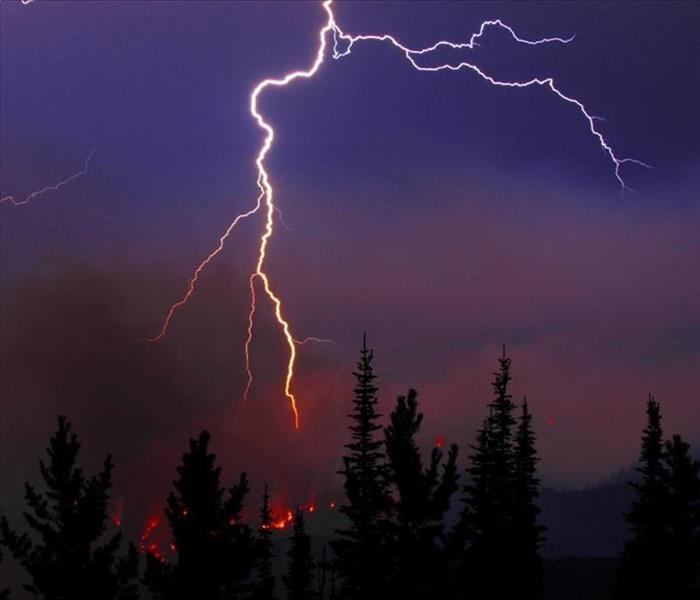 When lightning strikes near a power line, it increases the electrical current. The extra burst of electricity can lead to computer & appliance damage.
When lightning strikes near a power line, it increases the electrical current. The extra burst of electricity can lead to computer & appliance damage.
Did you know that 50% of businesses never reopen after a fire or water disaster? SERVPRO of Canton is available 24 hours a day to get YOUR business back up and running, "Like it never even happened."
Thunderstorms are absolutely something to be conscious for. 6.5% of all property claims are due to lightning strikes. Wood and other flammable building materials can easily be ignited when lightning comes in contact or passes through them. In addition, high winds, heavy rain and flooding from a thunderstorm can destroy a business in minutes.
If not prepared for a quick recovery, the lost revenue of your business could mean closure.
That is why SERVPRO has local franchises across the nation. When an emergency situation arises, call one of our highly trained professionals, certified in water, fire and mold clean up and restoration.
SERVPRO of Canton can provide:
- Over 40 years of experience as leading fire and water cleanup and restoration providers.
- There are over 1,500 franchises servicing 48 states.
- More locations for faster responses.
- Quick response time to help ensure the damage is contained and the restoration process begins promptly.
- Large loss capabilities - no fire or water damage is too big.
When the next storm hits Canton, OH, call the professionals at SERVPRO of Canton - 330-966-2377, or Request Help Online.
Also consider joining our Emergency Ready Program and reduce business interruption following a disaster. Call for details.
Is Your Business Ready?
2/20/2018 (Permalink)
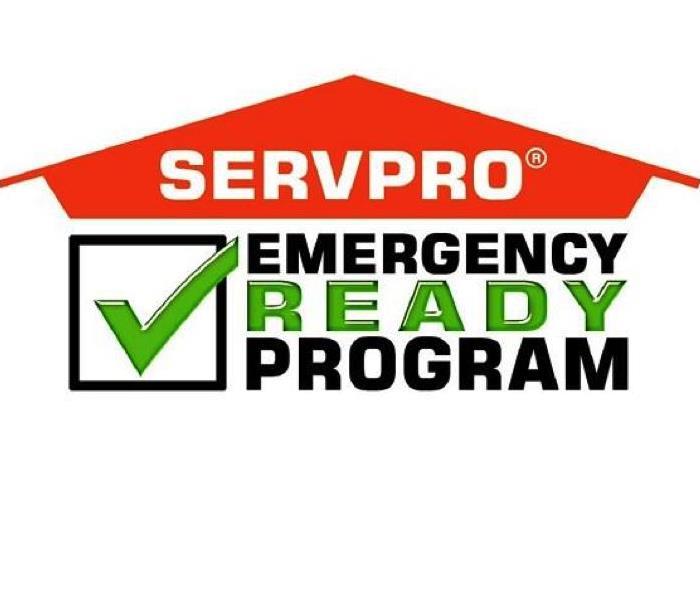 When disaster strikes, getting help is now quicker and easier using the SERVPRO Ready Plan.
When disaster strikes, getting help is now quicker and easier using the SERVPRO Ready Plan.
The best way to reduce business interruption following a disaster is to PLAN for it NOW.
The statistics uncovered by industry research say as many as 50% of businesses may never recover following a disaster. Of the businesses that survive, the majority had a preparedness plan in place.
SERVPRO's Emergency Ready Profile for YOUR business will minimize business interruption by having an immediate plan of action. With a no cost assessment of your facility, the program's profile includes your emergency contacts, all shut off valves and their locations, priority areas of your facility and more.
The SERVPRO Ready Plan provides solutions in advance of an emergency so that during the emergency you are "Ready for whatever happens."
Your business will receive the benefit of over 40 years of experience in reducing the impact of any natural or man-made disaster. Call now and take the next step in protecting and growing your business.
SERVPRO of Canton - 800-648-1212
And now with the SERVPRO Ready Plan Mobile App, help is at your fingertips. Call now and ask how to get started.
Agents: Watch Word Choice in Claims Letters
10/31/2017 (Permalink)
 Grammar matters.
Grammar matters.
The following bullets point out random errors in word choice. You may not lose a client because you make a poor word choice, but you’re not helping the relationship either. Here are several word choice issues to watch for as you phrase your letters:
- “ABC Insurance Company will make no voluntary payment of your claim…” Voluntary?
- "e.g., and i.e.," most people don’t know the difference. Use e.g., when you are giving examples; use i.e., to introduce your thought “in other words.”
- “Exception” and “exclusion” are words that have their own meanings. One adjuster wrote,” the exception that pertains to your loss can be found in your policy and is provided below for your reference. I think the word should be “exclusion.”
Here’s the difference: An insurance policy tells you what is covered.
Exclusions are classes of items that are not covered, such as nuclear war, acts of God, or terrorism. Exceptions are “exclusions to the exclusions, reinstating particular items within a whole category that had been “excluded.” For example, a homeowner’s policy may have an exclusion for all motorized vehicles. The exception to that exclusion might be a lawnmower, because a mower helps service the premises.
- “Said” – Very legalistic: “Said payment would allow you a discount of $300.” Just write, “This payment would allow you a discount of $300.”
- “Regard” and “Regards.” Do not write, “This is in regards to…” Write, “This is in regard to…”
- “Were” and “was.” Take the phrase, “If there were no coverage…” Using “were,” known as the subjunctive mood in English, represents situations contrary to fact.
- “Confirm.” When you confirm a lunch date, you restate your agreement as to the time and place. In insurance, however, it’s common to see a claims letter that starts, “This will confirm my phone call of 4/11/17." But what does “confirm” mean? Is the writer summarizing the previous call? Documenting it? Confirming is something you do to re-check a future date or agreement.
- “Advise.” About 80 percent of the time claims people use “advise,” they just mean “tell” or “inform.” No need to use “advise” in a sentence like, “Let me advise you that it will rain today.” There is no “advice” being given. However, if you write, “Let me advise you to bring your umbrella,” you are using “advise” correctly.
"Your grammar is a reflection of your image. Good or bad, you have made an impression, and like all impressions, you are in total control." -Jeffrey Gitomer
Defending Your Family Business Against Fraud
10/26/2017 (Permalink)
 Fraud can occur anywhere within a company and the right controls can limit its successful execution.
Fraud can occur anywhere within a company and the right controls can limit its successful execution.
In a study done by the Association of Certified Fraud Examiners (ACFE), the 2016 Global Fraud Study found that "businesses with fewer than 100 employees, which are in many cases family-owned, experience fraud at a rate of 28.8%, compared to the 19.8% experienced by those with more than 10,000 employees."
Smaller business often suffer more from fraudulent activities. It's more difficult to manage the damage it causes in a $5 million company than a $250 million company. This kind of activity also damages the company culture.
The median fraudulent loss suffered by small organizations is the same as large organizations: $150,000. However, while it is the same number, this number takes up a larger percentage of the small business revenue.
Here are 5 ways to defend your small business from fraudulent activities and enforce internal controls:
- Segregate financial duties. Create a three-person system of checks and balances: one person opens the bank statements, one prepares the bank reconciliations, and a third reviews all transactions and canceled checks.
- Stay away from signature stamps. Family and small businesses should require two signatures for any payment over a certain monetary amount.
- Establish routine checks of payroll, supplier and vendor lists by multiple people within the company. The final payroll list should be reviewed by someone other than the person distributing checks and preparing the payroll, and the list of vendors should periodically be checked for unrecognized names.
- Educate employees on financial reporting. To increase levels of security, outsource your financial reporting and ensure someone is monitoring for fraud.
- Every employee — including family members — should understand protocols in a business from expectations to pay rates and benefits. Clear expectations help avoid a power struggle and will clearly define who is double-checking various aspects of the business.
Fraud can happen anywhere. The more you believe it won't happen to your business, the more susceptible you become to it.
Source: 5 Ways to Defend Your Family Business Against Fraud by Bill Kowalski
Hotel Chain Suffers Water Loss: What Will the Carrier Pay?
9/6/2017 (Permalink)
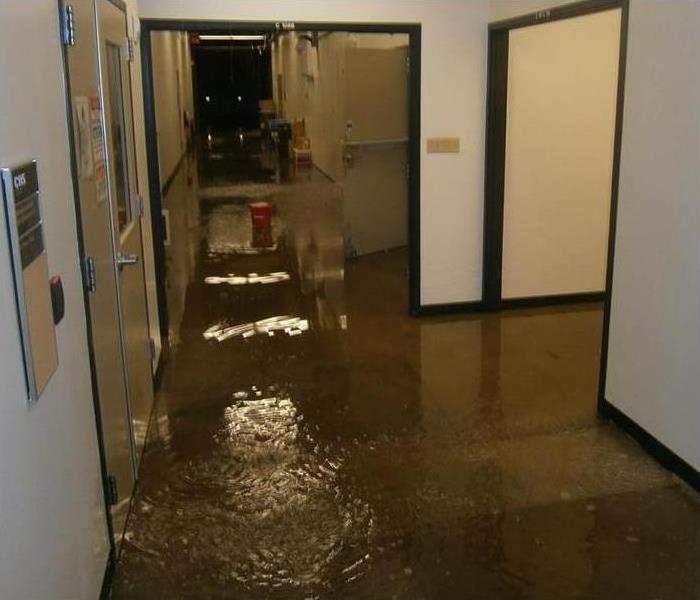 The extent of the destruction will be the most determining factor when calculating price. Most restoration companies bill by the square foot.
The extent of the destruction will be the most determining factor when calculating price. Most restoration companies bill by the square foot.
Inside a Property Casualty article discussing property damage repairs and what the carrier will cover in replacement costs, there is a question regarding a water loss at a hotel chain with a replacement cost policy. Read below:
Question: Our insured is a hotel that suffered water damage to some of its rooms. The insured is a franchisee and has an agreement with the hotel chain that requires replacement of damaged decor with current decor; all of the rooms on the same floor must be updated to the current decor. The hotel has a replacement cost policy, but the other furniture was not damaged. The carrier's position is that it is not responsible for the non-damaged rooms. What should the carrier pay?
Answer: This scenario differs from the matching issue, about which we often receive questions. The carrier is correct in not paying to bring all of the rooms up to the current decor. There is no loss or damage to the other rooms, and while the rooms would not match each other, this is not something that would be apparent to guests. Nothing in the self-contained rooms themselves would be mismatched.
If the chain requires franchisees to maintain a uniform look to all rooms on a floor, that falls more under the cost of doing business. If the rooms themselves are not damaged, it is not an insurance matter to bring them up to speed with the other rooms.
If items in the rooms themselves are not matched, that would be a different matter. For instance, if a headboard needed to be replaced on one bed but a matching one could not be found, then both headboards should be replaced.
Does your commercial property have water damage? Call our 24/7 Emergency Service number, 330-966-2377, or ask for help online.
Read more on our Commercial Restoration Services.
Winter is Coming: Prepare Your Business for Winter
9/5/2017 (Permalink)
 A winter storm can bring with it sleet, ice, high winds, and heavy snow, which can result in sudden unexpected commercial property damage.
A winter storm can bring with it sleet, ice, high winds, and heavy snow, which can result in sudden unexpected commercial property damage.
September has arrived and before we know it so will Halloween, then Thanksgiving, then the holidays. Is your business ready for the frigid temperatures, the heavy snowfall?
According to Leavitt Group's article, Prepare Your Business for Winter Weather, In the past five years, 15 percent of small businesses have experienced damages caused by water and freezing. The average cost of these claims is $17,000.
Leavitt Group also discusses common types of winter-related damages, including:
- Damage to contents, inventory and equipment caused by significant temperature changes.
- Water damage caused by pipes freezing and bursting.
- Wind damage to roofs, buildings and landscape.
- Fire suppression efforts delayed by inaccessible fire hydrants (covered by snow or ice)
- Frozen fire suppression sprinkler pipes, resulting in flooded rooms and malfunction of system.
- Ice damming, resulting in damage to roof and gutters.
- Injury to guests and employees.
- Loss of revenue (business interruption).
Taking preventative actions now while the weather is still warm is incredibly important and could save you business a lot of time and money. Here are some maintenance tips Leavitt Group suggests in preparing your business for winter:
- Drain water from all systems and equipment not needed in winter months, including landscape sprinklers and air conditioning units
- Check for and repair damages to the roof. Make sure roof drains are clear and in good condition. Clear rain gutters to ensure proper drainage and make sure downspouts are intact and draining in areas away from foot traffic
- Inspect the exterior of the building for gaps and seal appropriately to prevent weather and critters from getting inside
- Trim tree branches and lanscape that might come in contact with the building in the event of heavy snowfall and ice accumulation
- Make sure the heating system has enough fuel for unexpected conditions and a back-up in case of emergency
- Maintain a temperature of at least 45 degrees Fahrenheit in unoccupied facilities, attics and basements
- Make arrangements for snow removal with a reputable company before winter starts- don't wait until the storm hits and you are buried under a pile of snow. Discuss snow removal from the roof. To avoid damages from snow removal equipment, mark curbs, fire hydrants, drains, speed bumps and other features that may not be visible under a layer of snow
- Make sure you have sand, ice melt and shovels on hand for winter maintenance that won't be covered by your snow removal contractor
Begin checking off your maintenance needs while the weather still allows for it. Stay tuned for our next blog for commercial property owners, "Developing a Business Continuity Plan for the Winter Weather."
Have questions? Call our office at 800-648-1212 or our 24/7 Emergency Service number at 330-966-2377.
Creating a Killer Facebook Ad Campaign for Your Business
9/1/2017 (Permalink)
Marketing on Facebook doesn't have to be confusing and intimidating. Here are some things to consider when developing your Facebook Ad campaign, a simple and straightforward strategy that will expose your message to your ideal market and present a relevant message that drives prospects to take action:
- Target your audience. Identify your ideal client, find people who had had “liked” groups related to the subject, target a specific ZIP code or individuals who fall between certain ages. Facebook allows you to filter these and more demographics.
- The ideal budget. Facebook allows you to start your campaign budget at $5. As you progress, so can your investment.
- The perfect Facebook Ad. What should it look like?
- Don't mention pricing. Studies show that ads without price have 10% higher conversion rates.
- Add a face to the ad.
- Choose images that show the desired result of your clients, where they will be after your work.
- Test Red vs. Blue. Studies also show ads with red and blue have 20% higher conversion and click-through rates.
- Use a "call to action" button, such as "Apply Now."
- Where should the clicks go? You do not want to send your prospects to the home page of your website. Direct your traffic to a landing page where they can download a report, where the only action they can take is the next step in the process.
For details and graphics on this subject, click here to read the main article.
Cybercrime From An Insurance Perspective
9/1/2017 (Permalink)
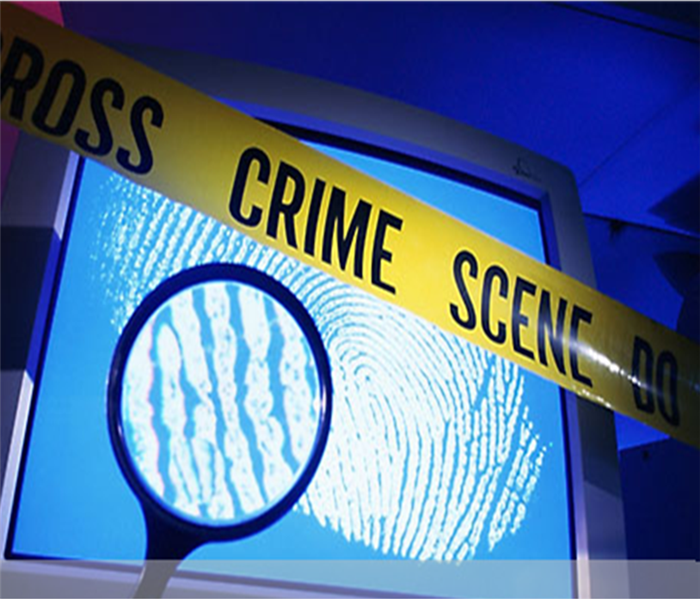 MyDoom is considered the most expensive virus in the world and in cyber security history, having caused an estimated financial damage of $38.5B.
MyDoom is considered the most expensive virus in the world and in cyber security history, having caused an estimated financial damage of $38.5B.
We've heard the stories. Cyber hacks influencing the presidential election, ransomware attacks across the globe. We might even think the hackers are winning the war- the cyber war, that is.
Insurance Business America discusses this matter with an insurance perspective in a recent article, interviewing James Shaheen, cyber risk practice leader at Integro.
According to Shaheen, with every attack, our cyber security experts learn something new, and counter every attack with a defense. It will take us some time, though, to figure out what we need to implement, where the gaps are in the security, to fully protect our data.
When it comes to insurance, Shaheen believes we are doing well in the protection of Protected Health Information (PHI), Personally Identifiable Information (PII) and the Payment Card Industry (PCI), but the concern is what he calls "second-tier data."
Second-tier data, or trade secrets, is what drives businesses, and is also what is not well protected by insurance from these cyber attacks.
Shaheen claims at Integro this is an issue being addressed and developed. How much would such a development be worth to your business?
To read Insurance Business America's article and for related stories, click here.
Restoring Your Canton, Ohio Commercial Property After A Water Damage Event
10/13/2016 (Permalink)
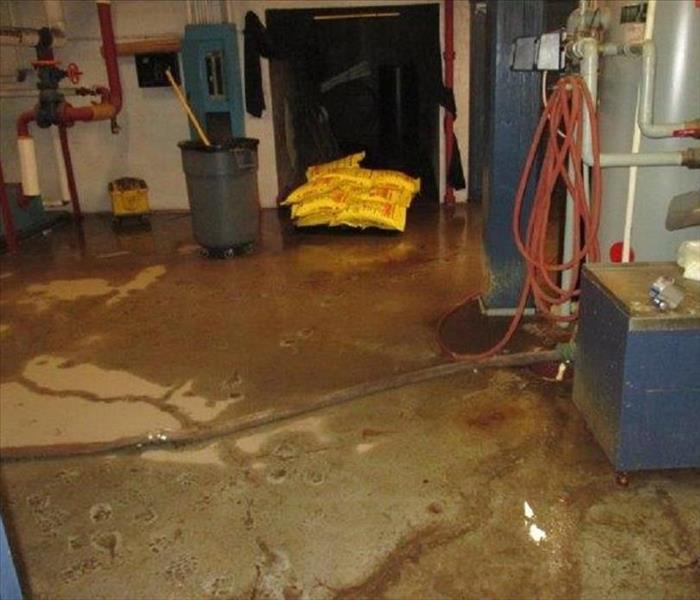 Commercial Water Damage Events Present Unique Challenges
Commercial Water Damage Events Present Unique Challenges
Flooding and water damage events at Canton, Ohio commercial properties are often complex with numerous issues that require a knowledgeable and flexible response. Whether we’re dealing with a relatively small water cleanup scenario or a large scale event, we work quickly to assess each unique situation and isolate the damaged area. In many instances, normal operations can continue in a temporary space while we restore your facility.
Restoring Commercial Properties Presents Unique Challenges
Our professionals are trained to be mindful of legal and environmental concerns and strive to fully restore the damaged area while working within your budgetary constraints. We understand that every hour spent cleaning up is an hour of lost revenue and productivity. So when an emergency situation arises in your business, give us a call and we’ll be there fast with the help you need.






 24/7 Emergency Service
24/7 Emergency Service

